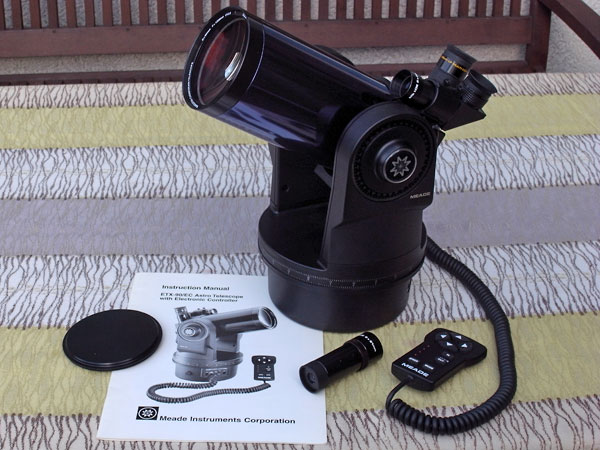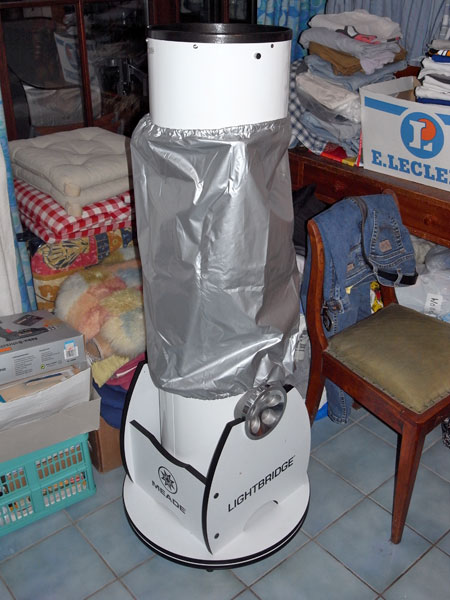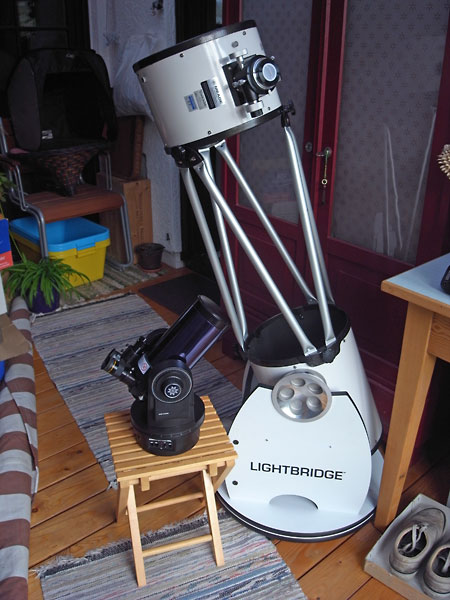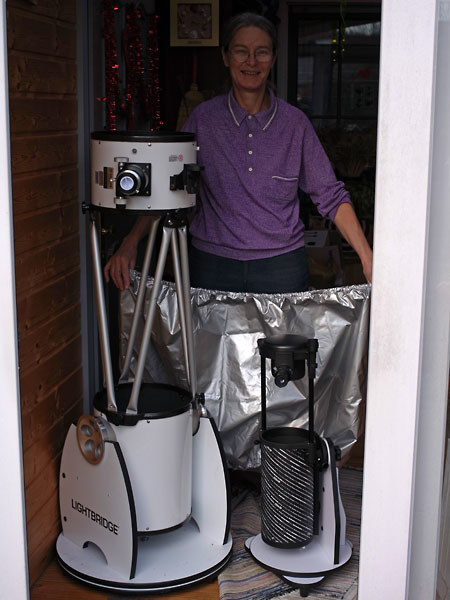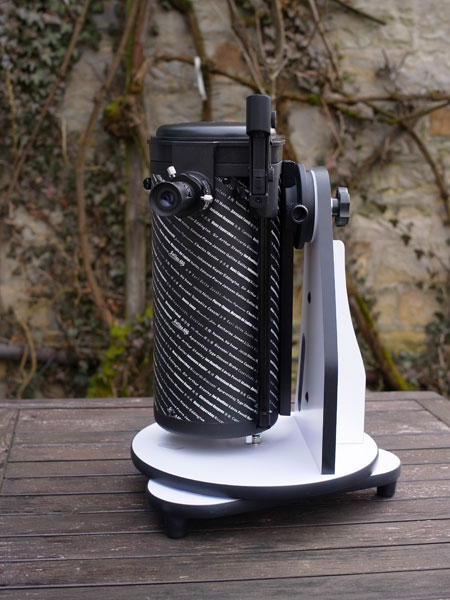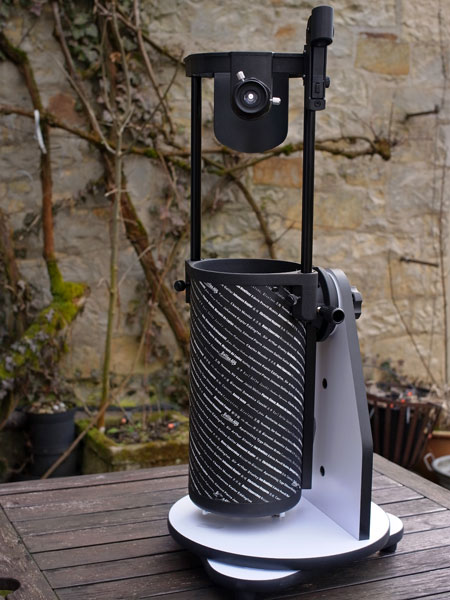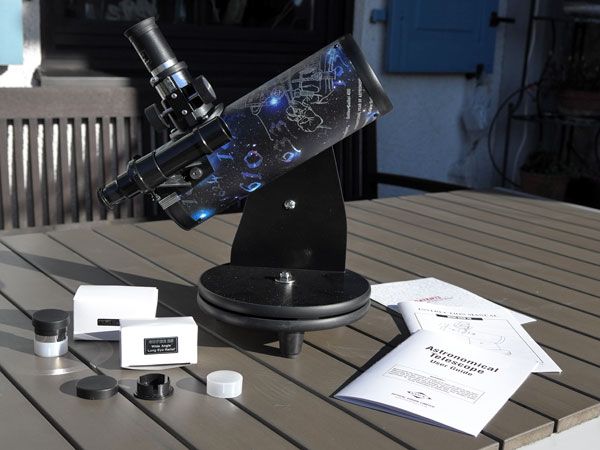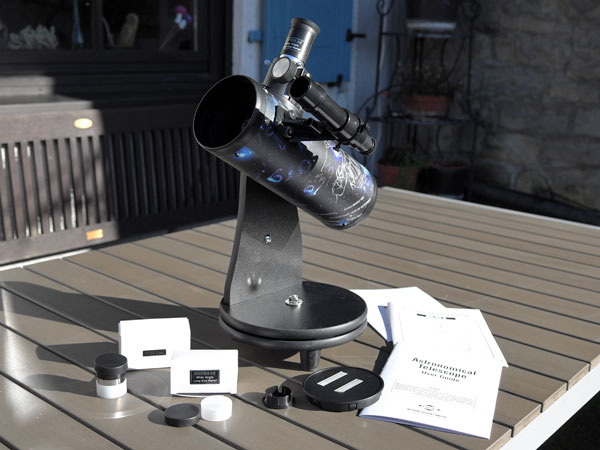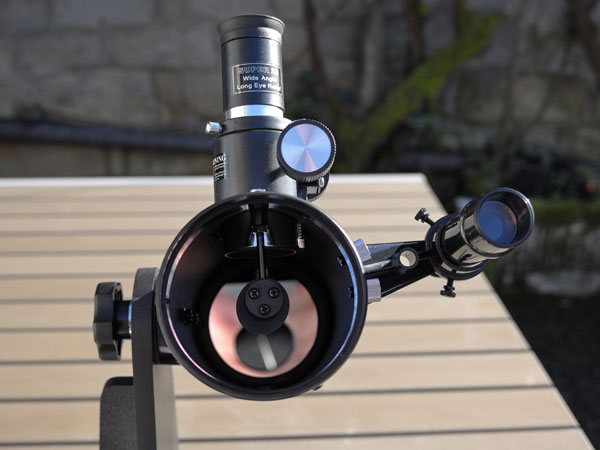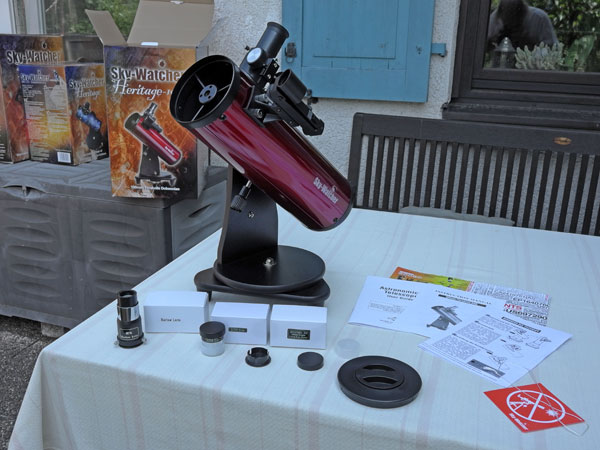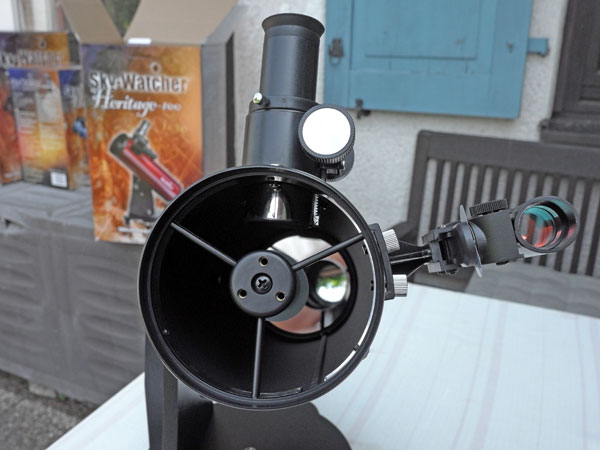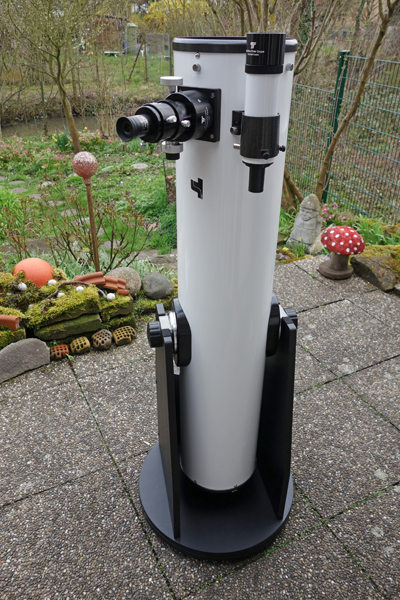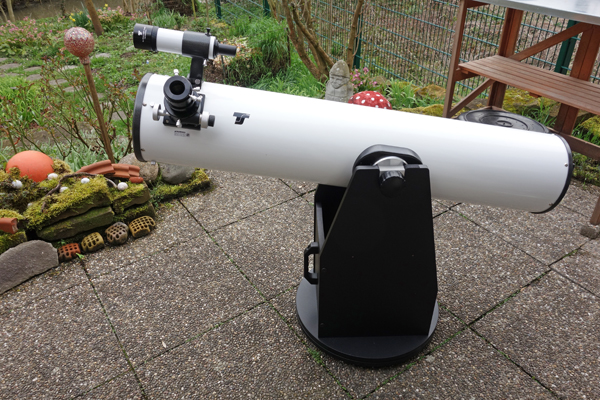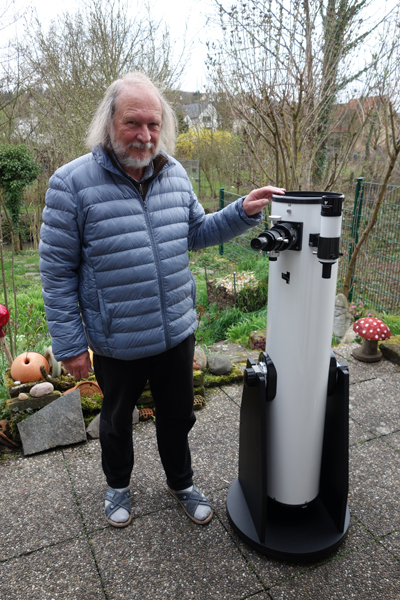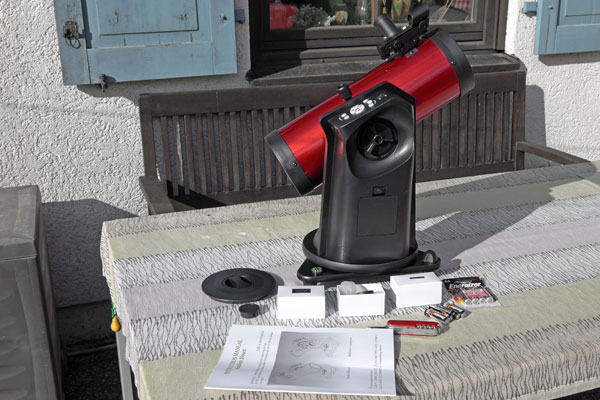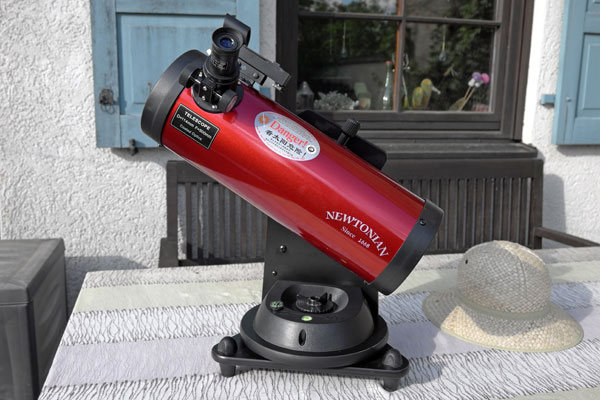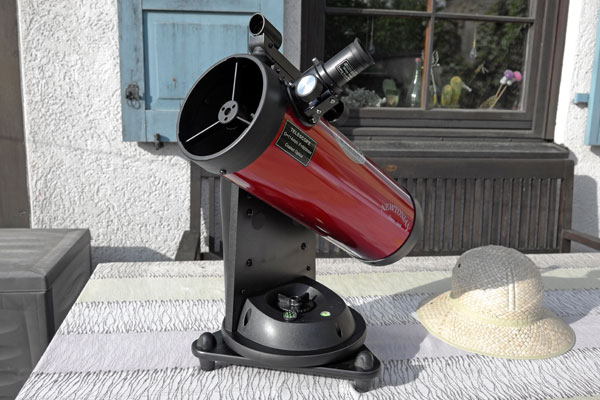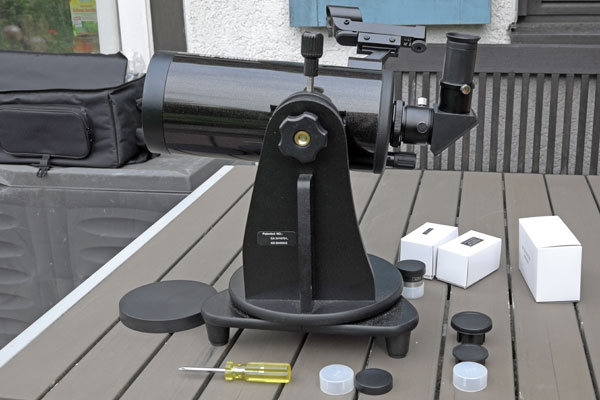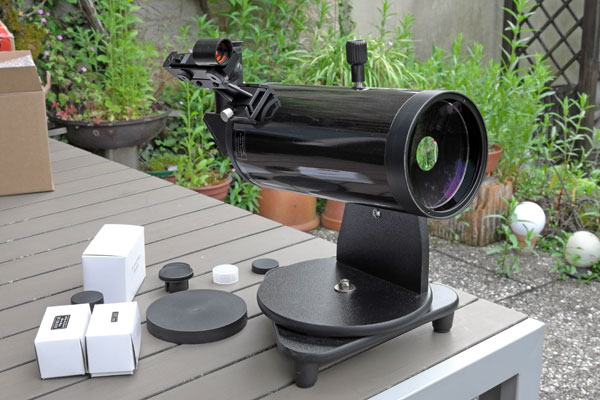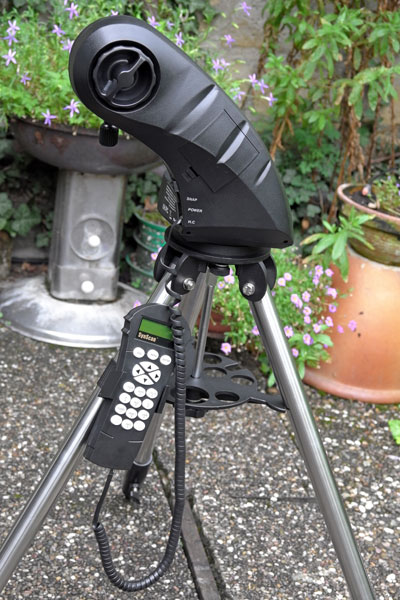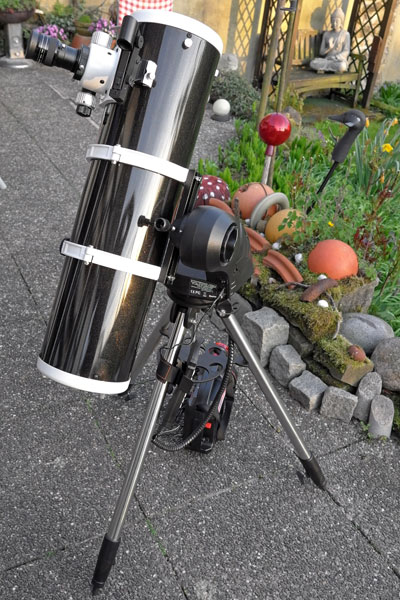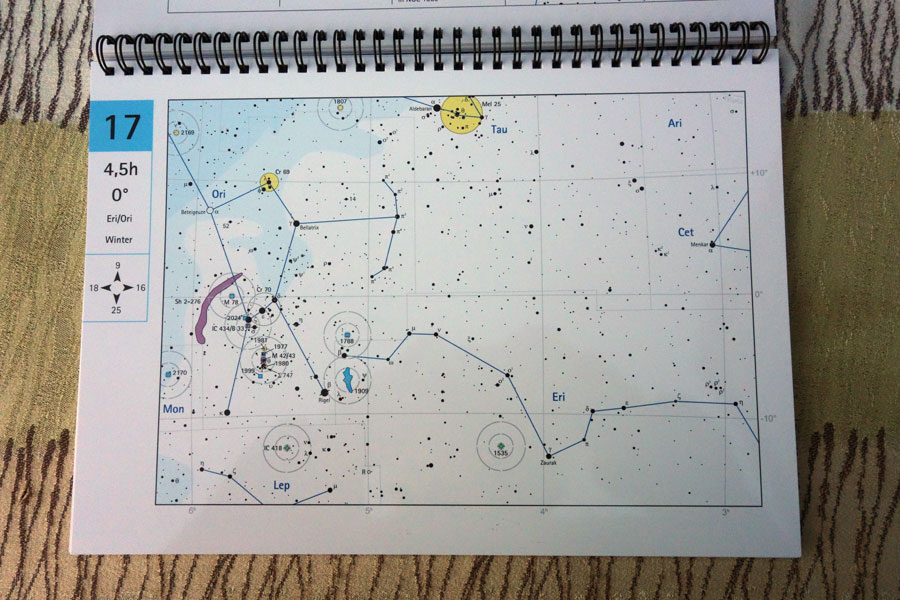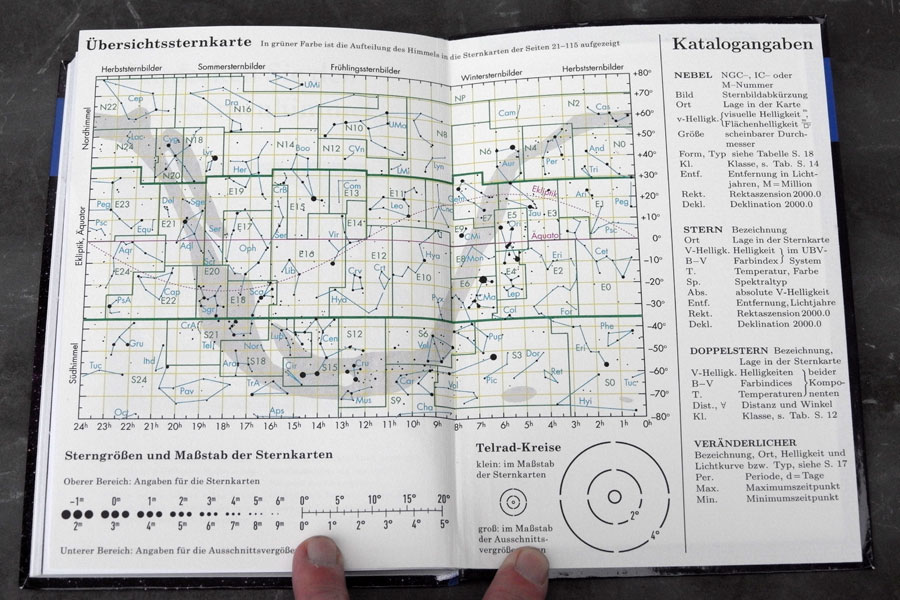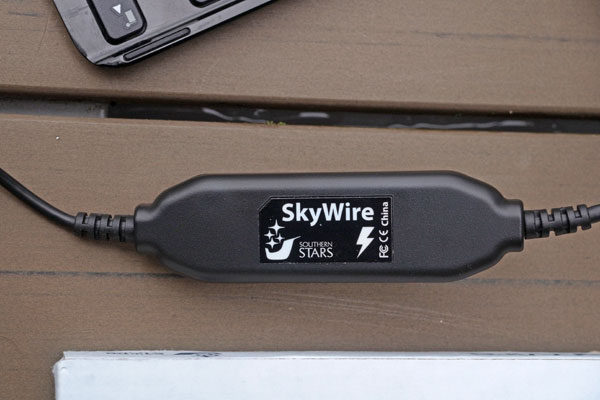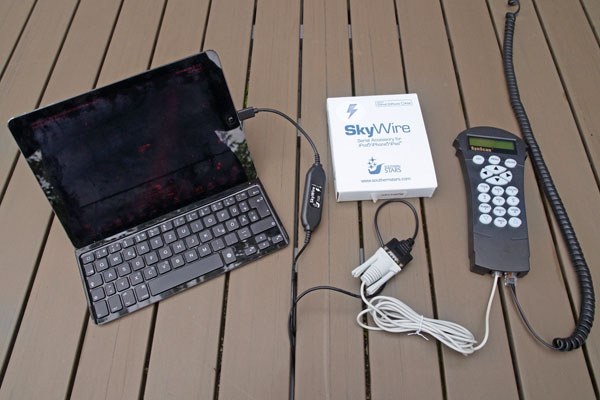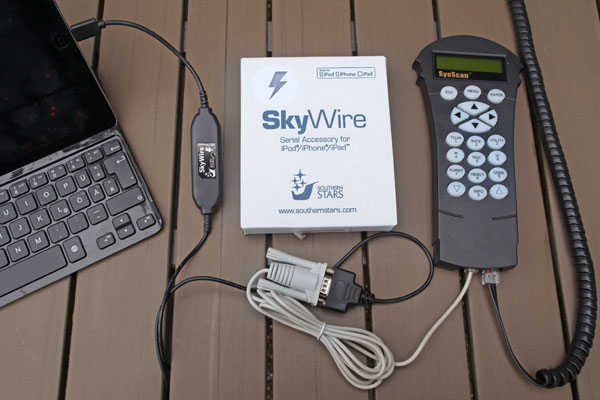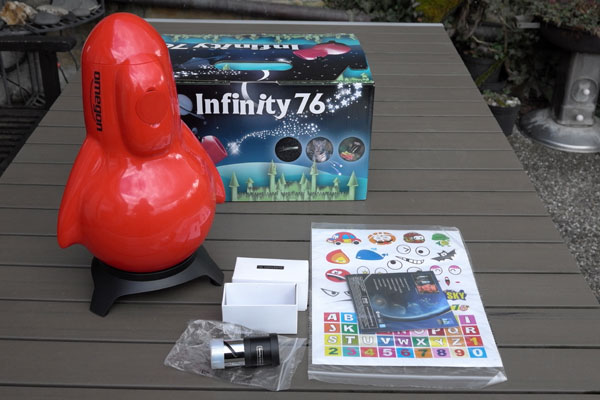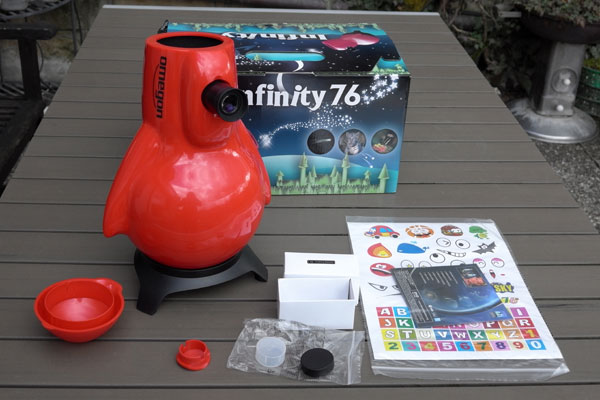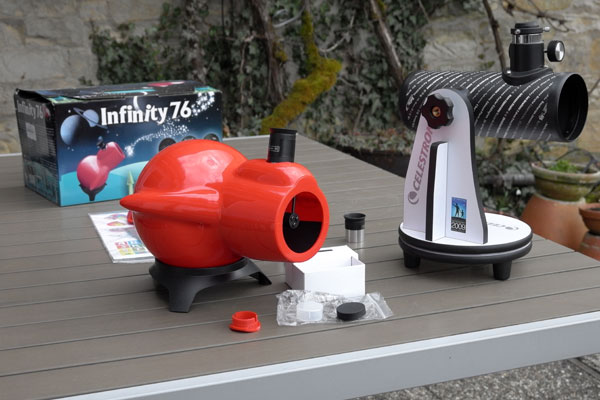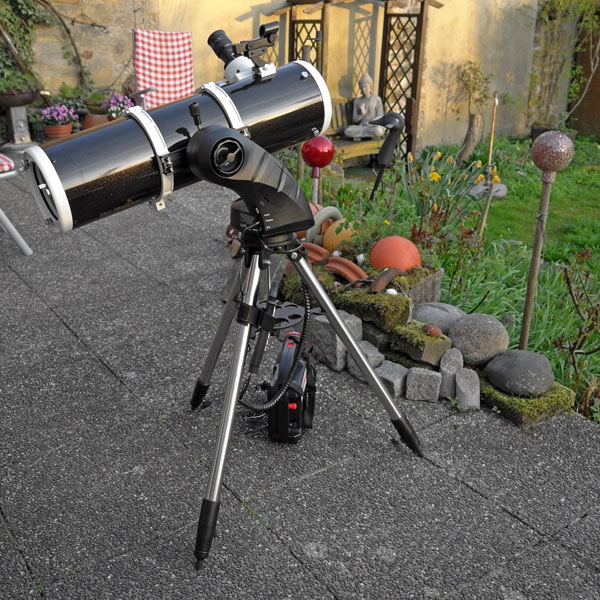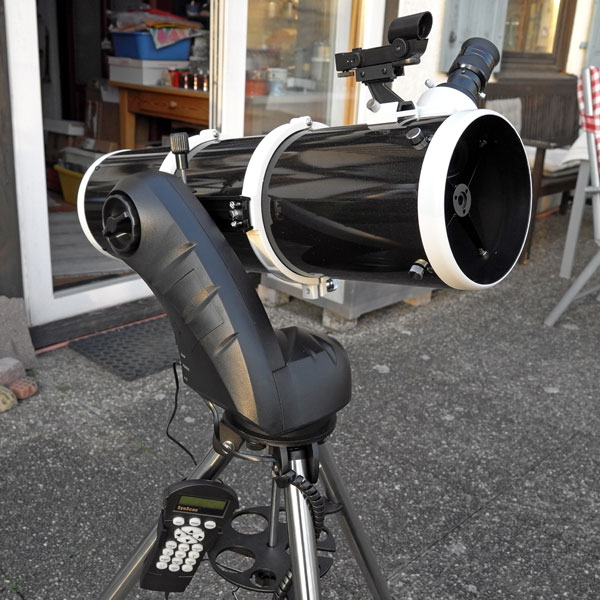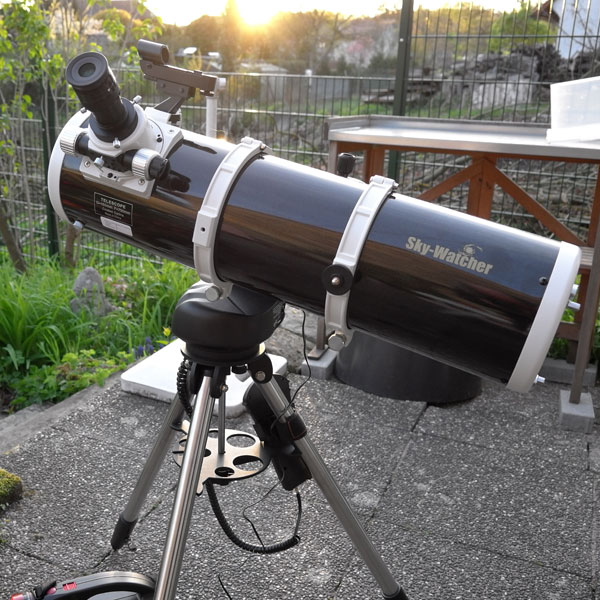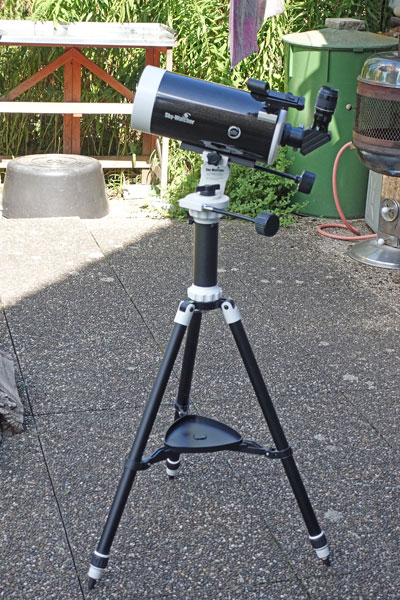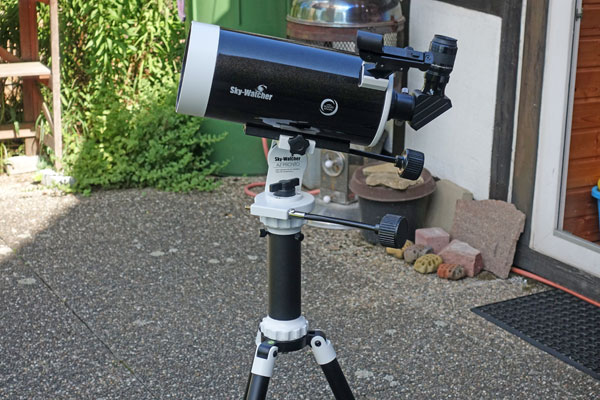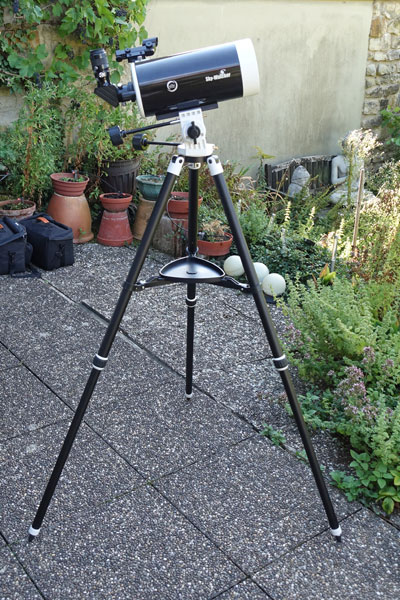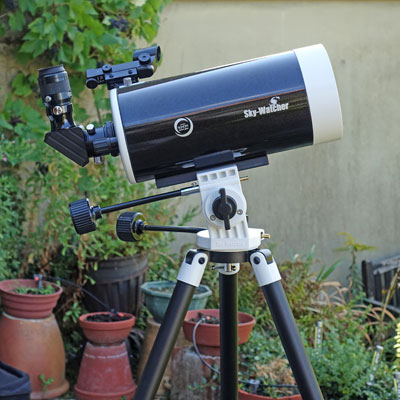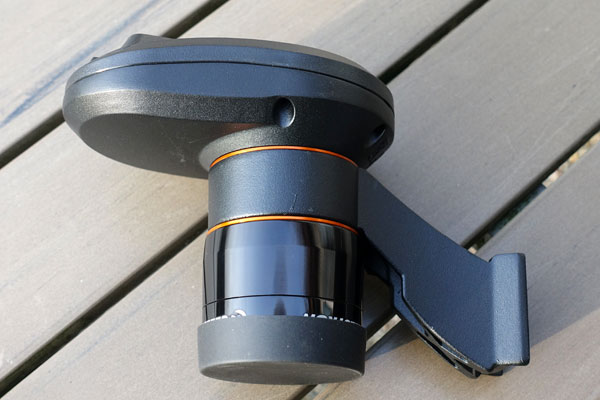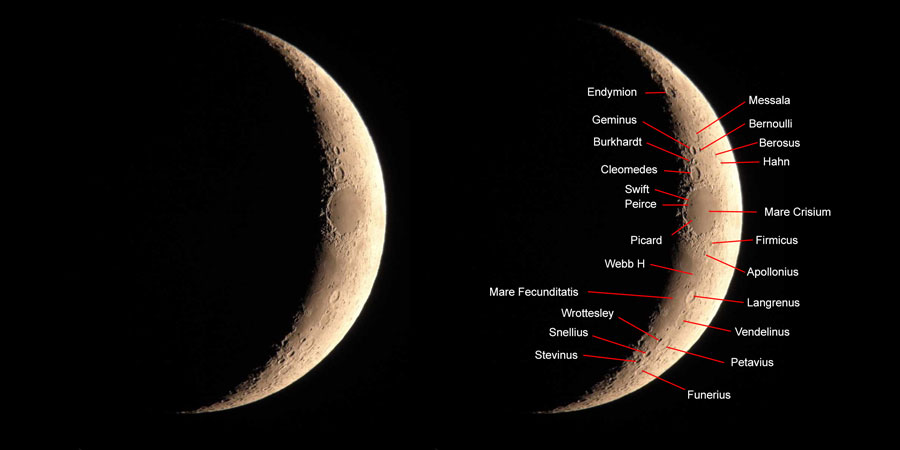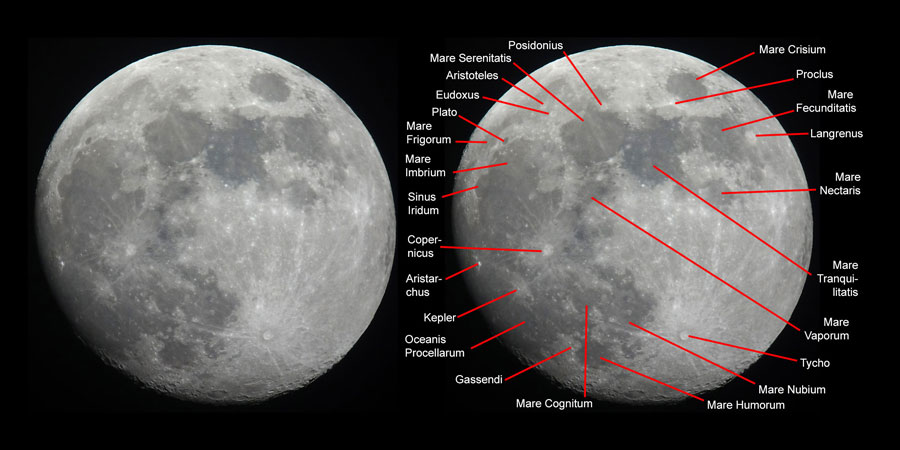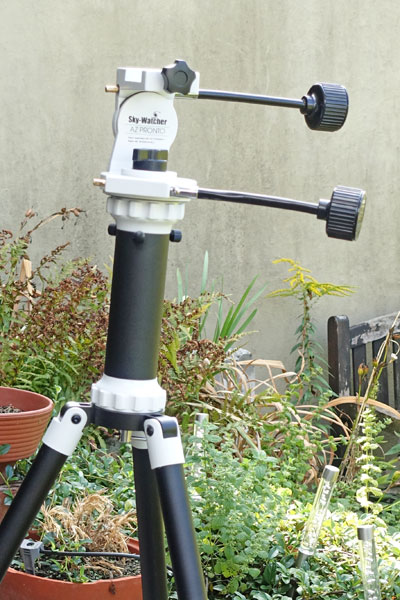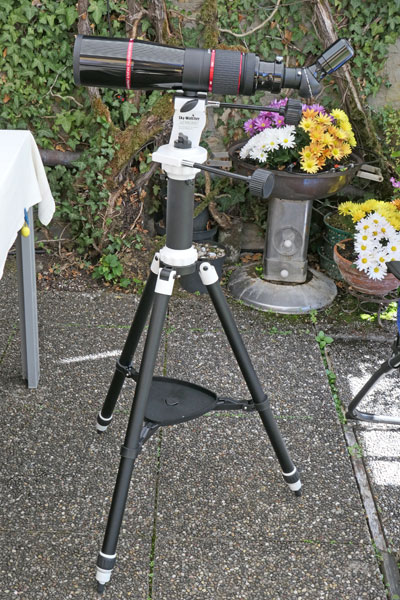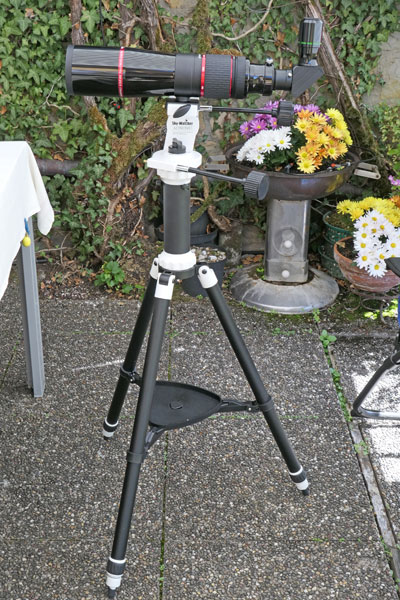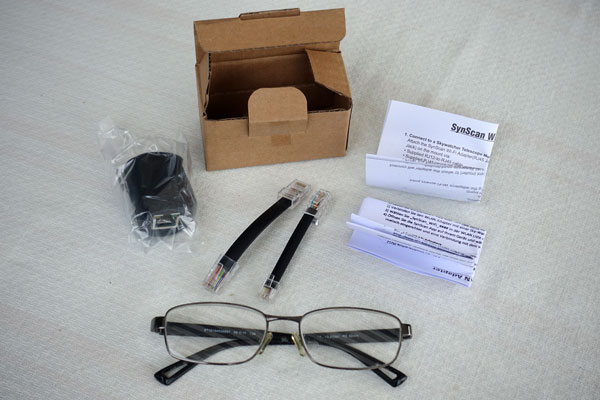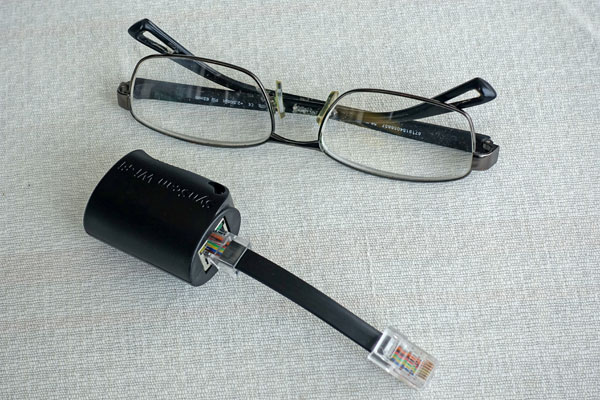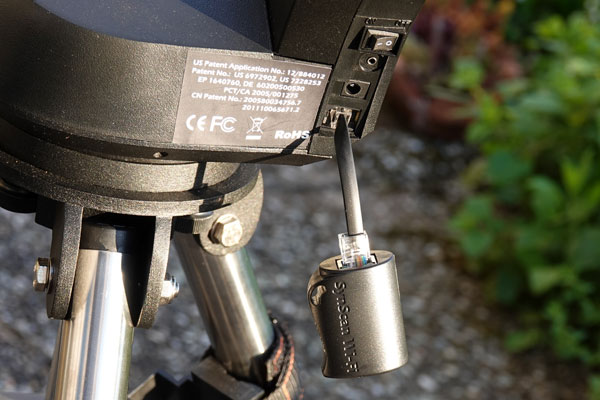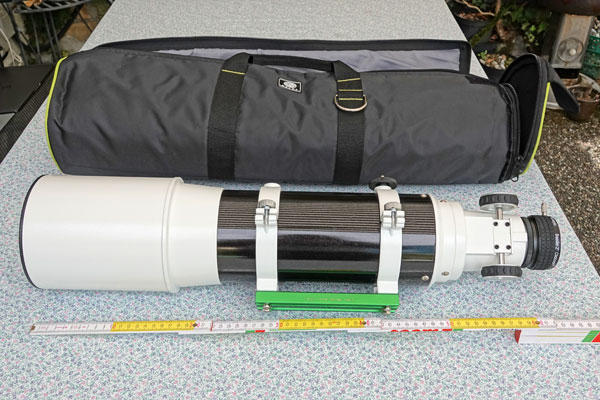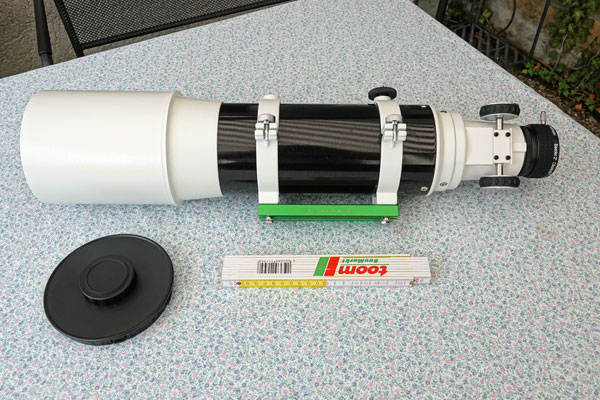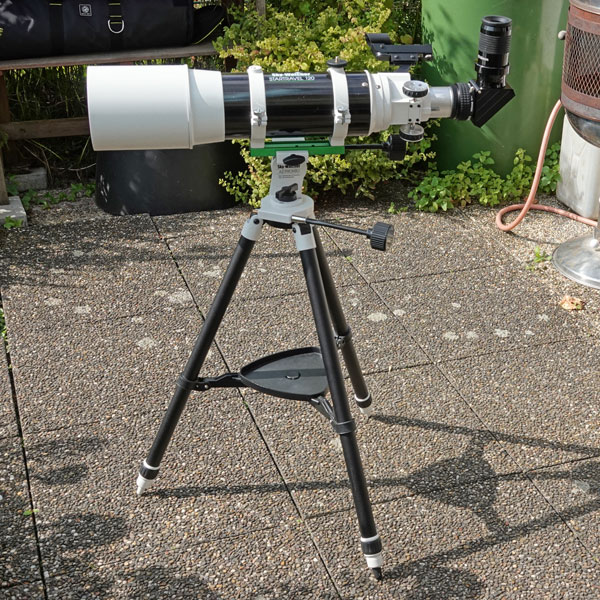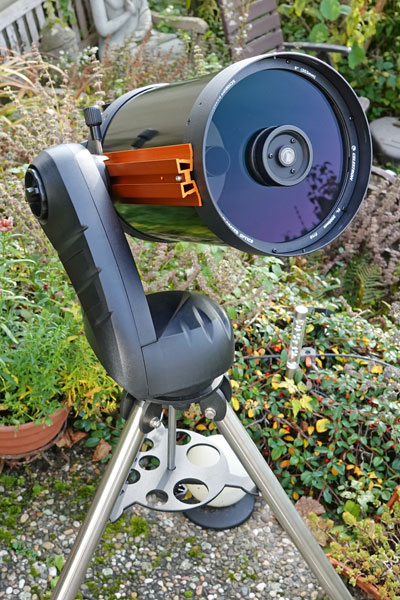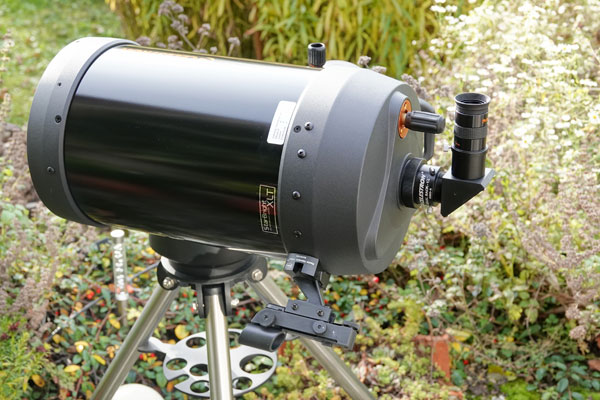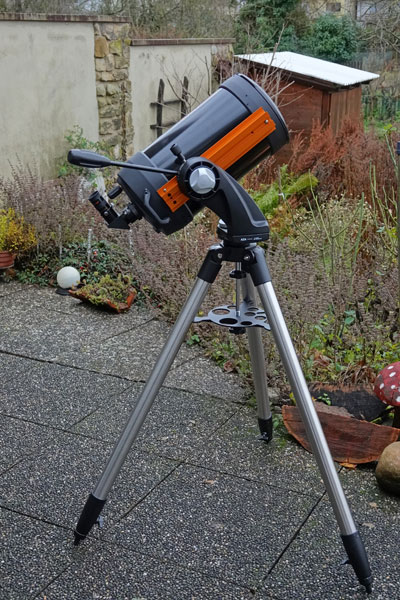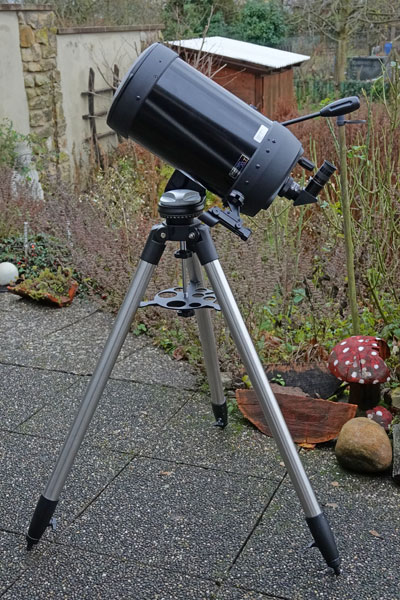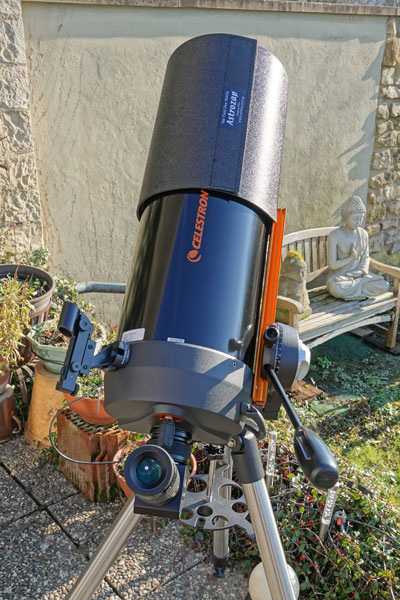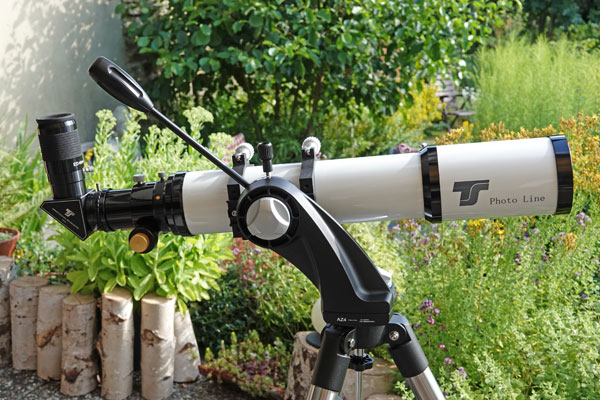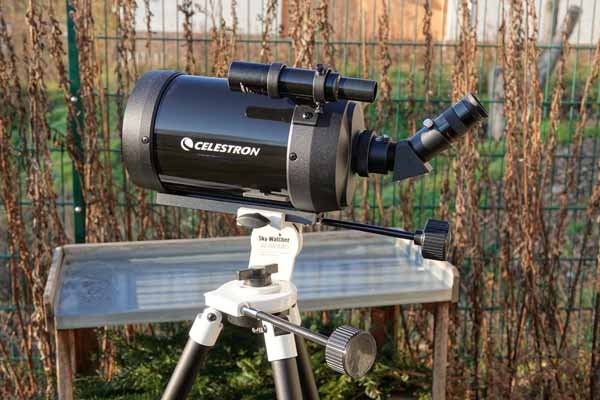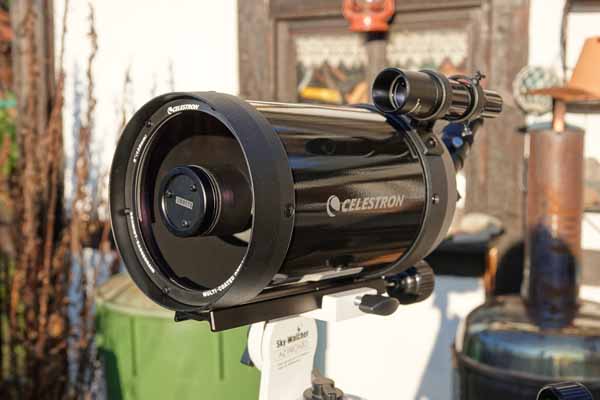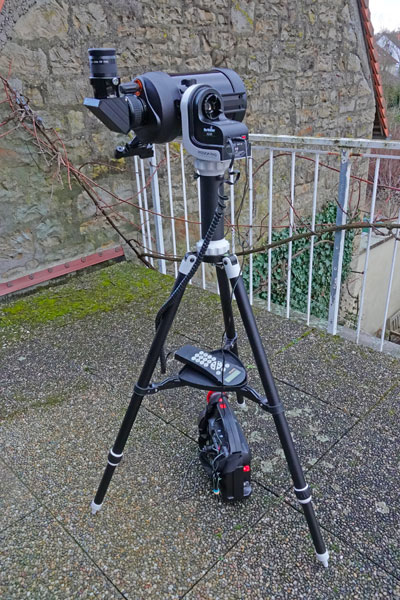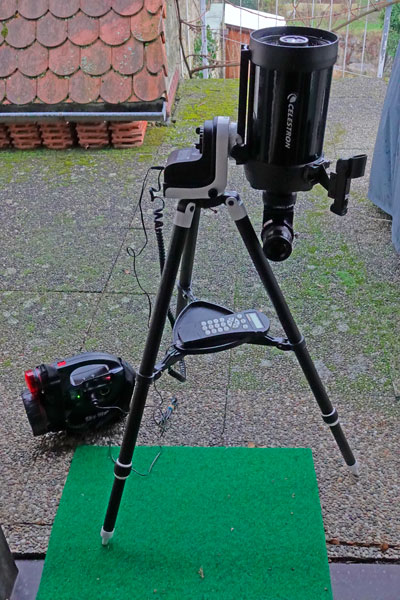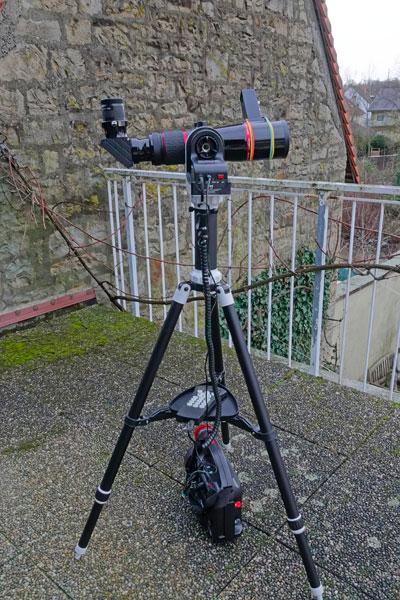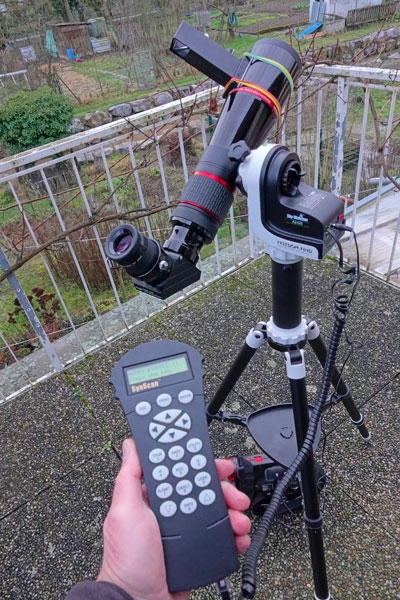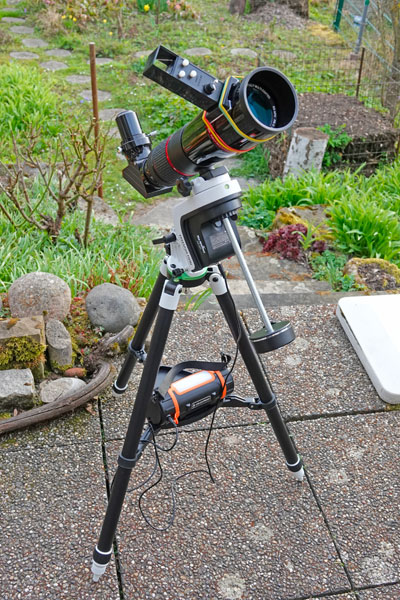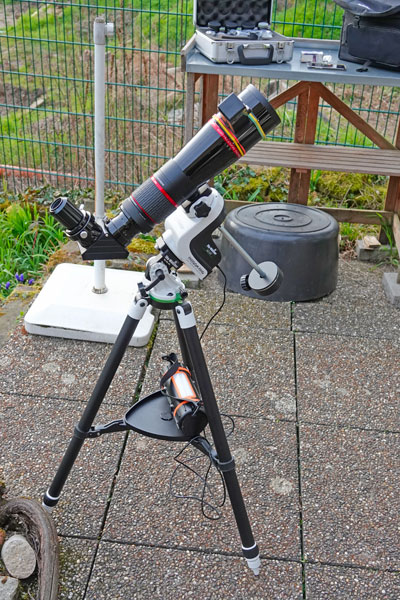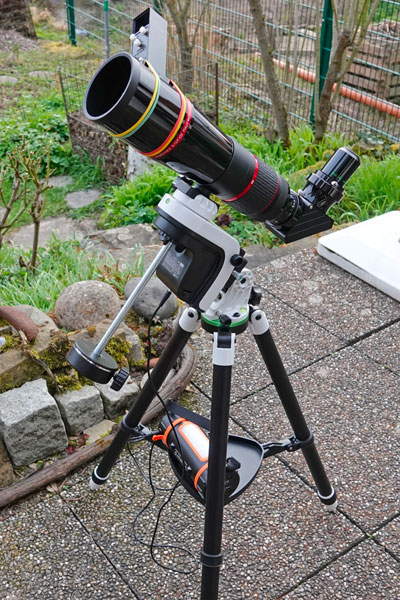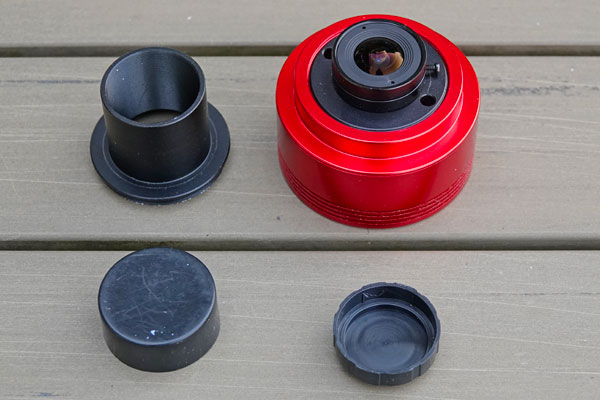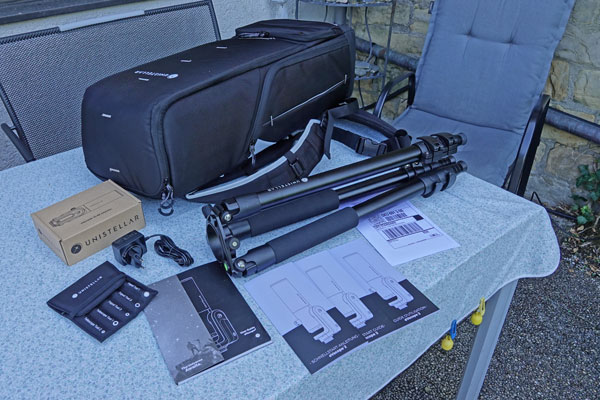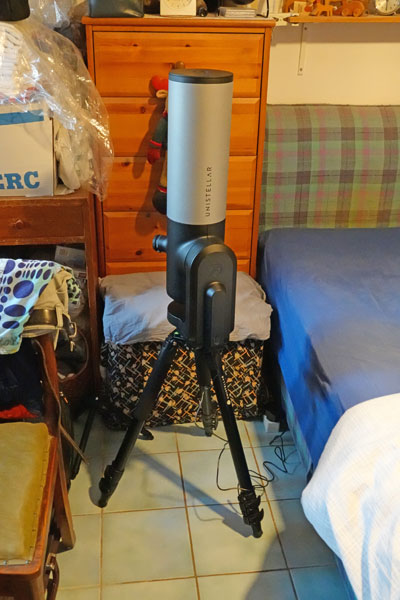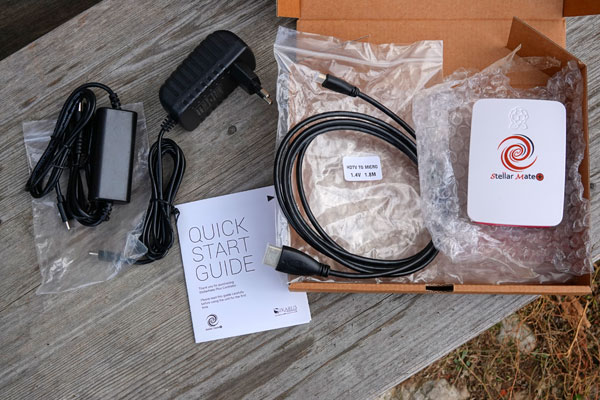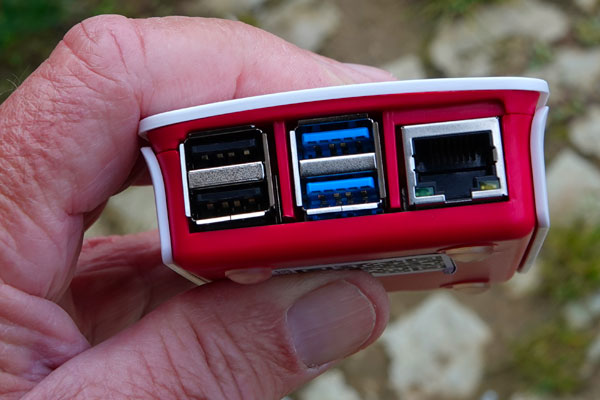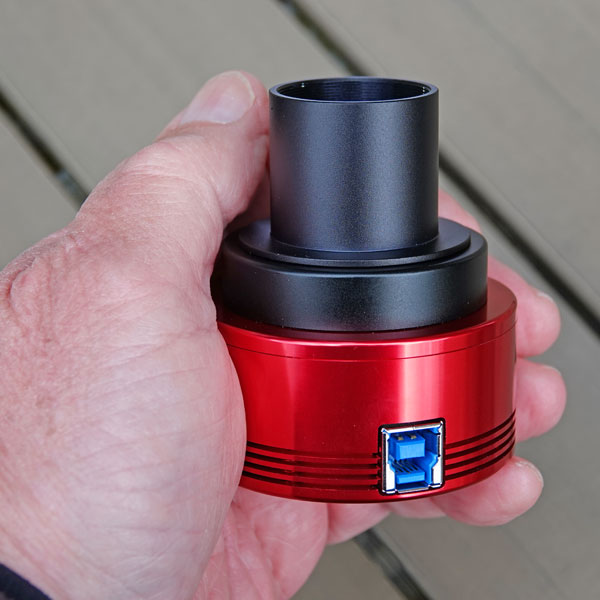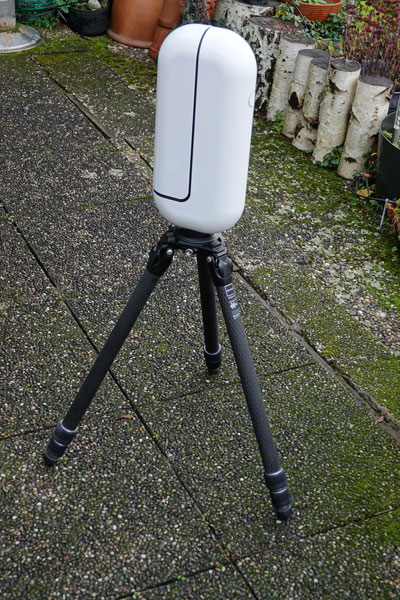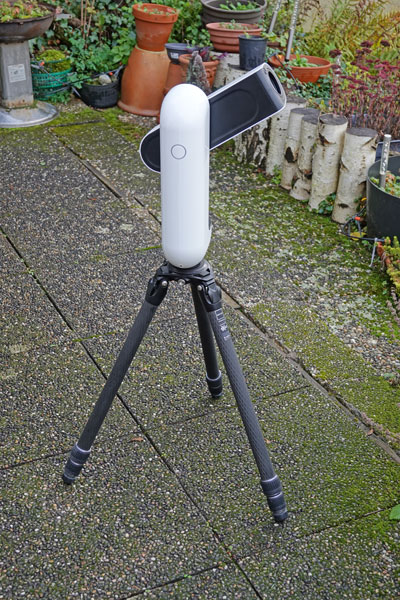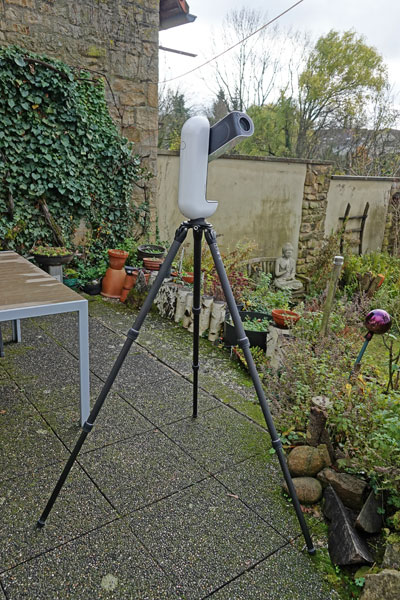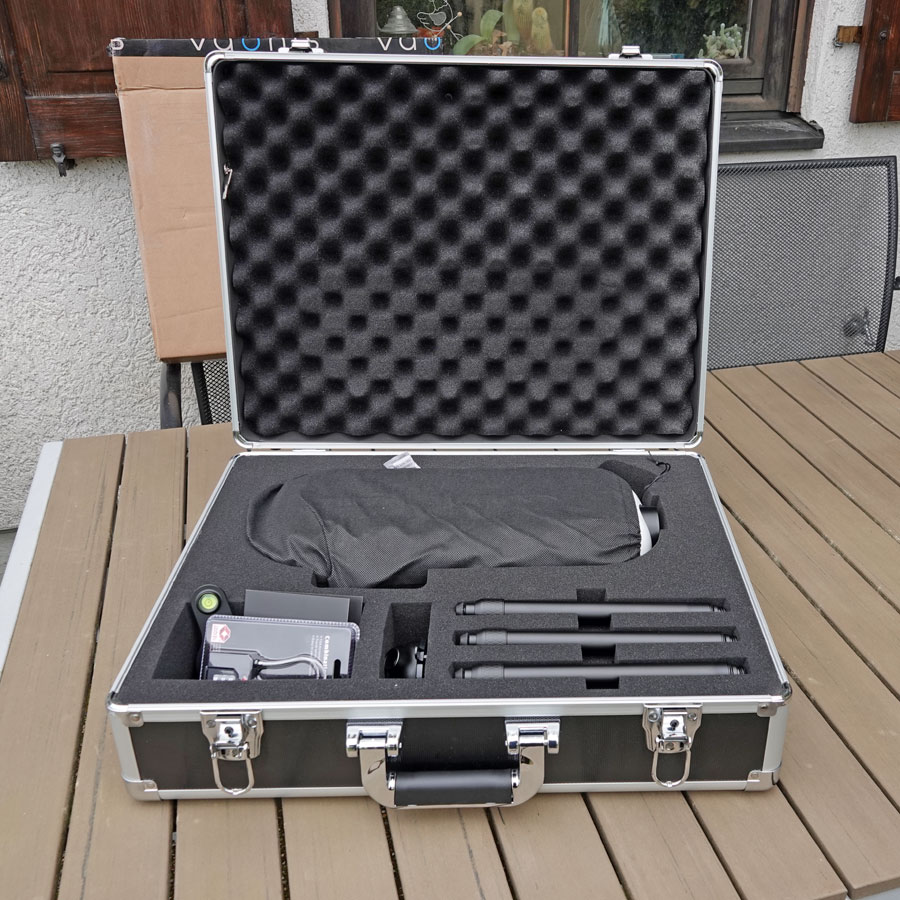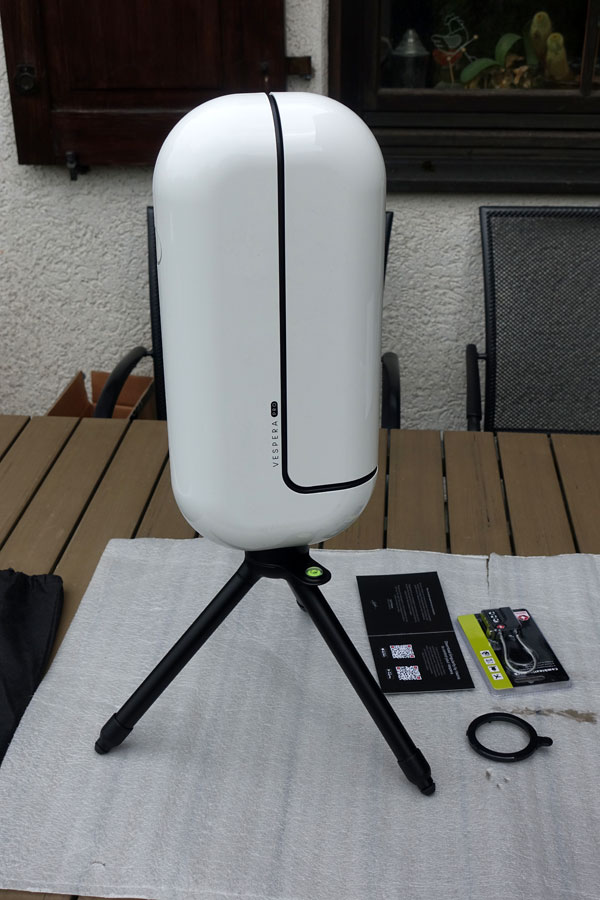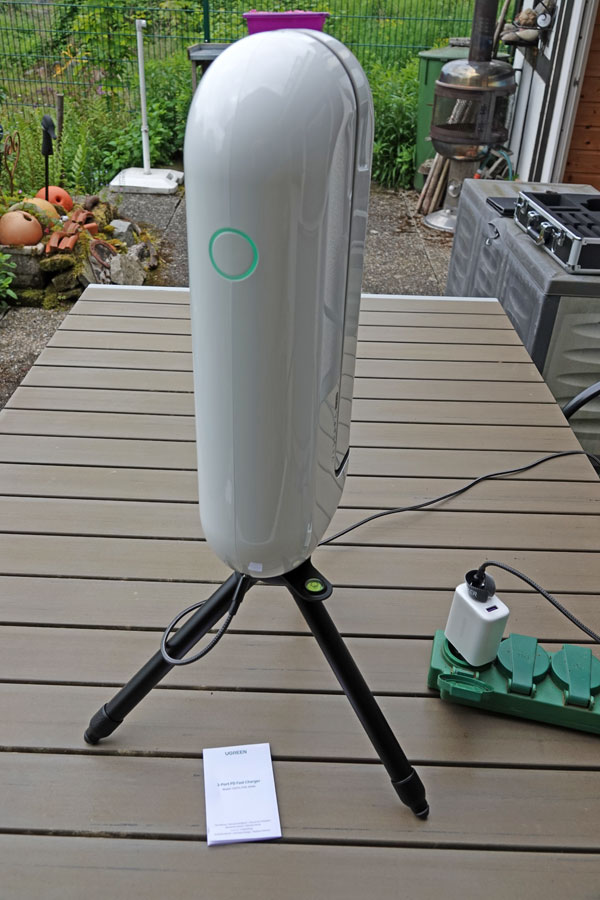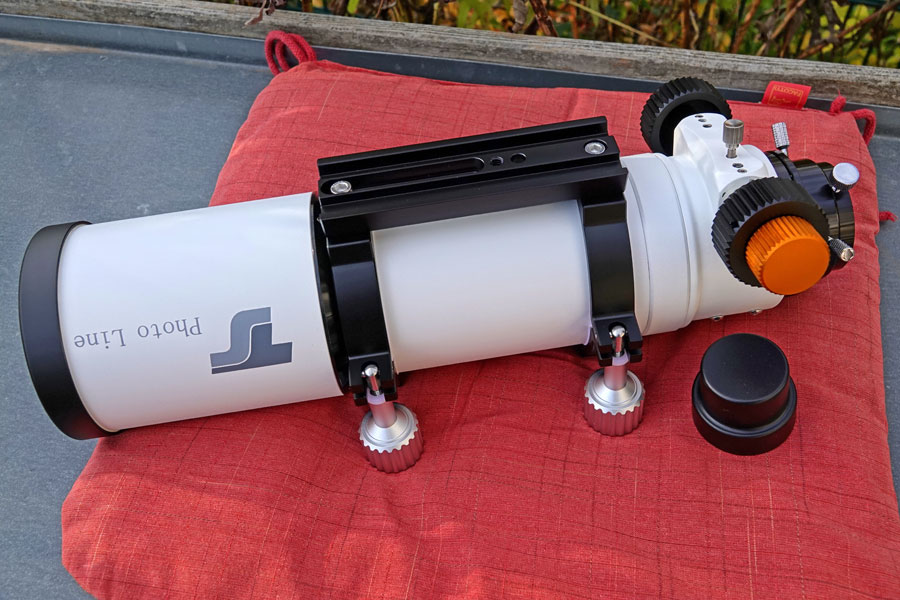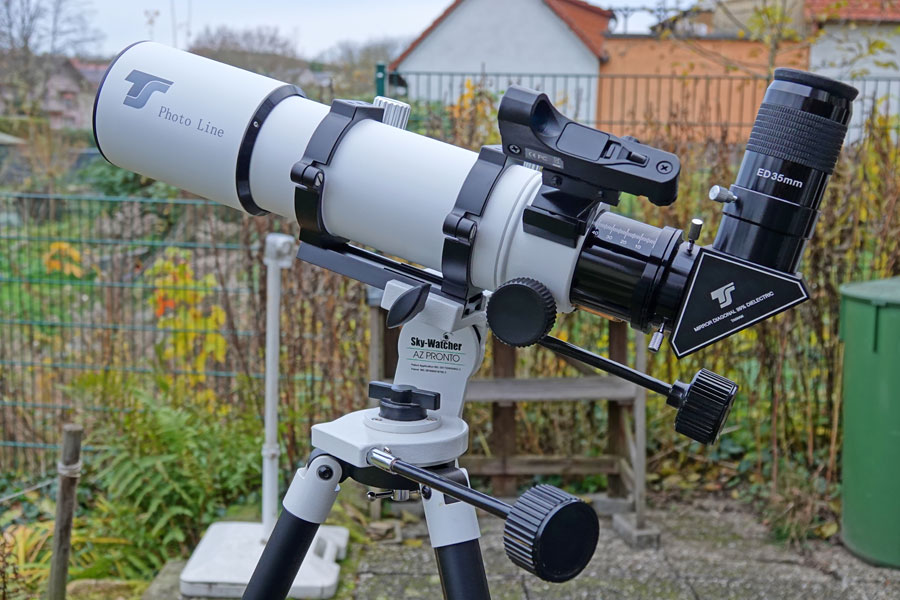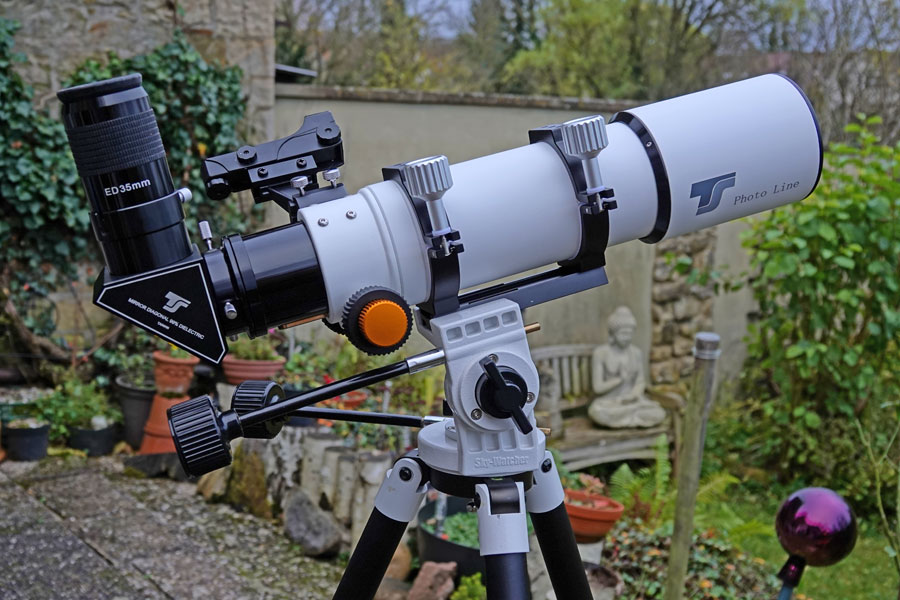My Astronomy History
Overview | The Beginning: From Bresser Venus 76/700 AZ to 10" Meade Lightbridge Dobson | The Mini Dobson Phase | Changes: From 10" down to 8" and 6", Entering DSO Observation and GoTo | Additions and New Topics | Timeline | Links
On this page I provide an overview of my "astronomy history" - probably more for myself than for others...
Notes
- See also page Overview of All My Telescopes (and a few others...)
- Here you can find an Overview of My Current Telescopes
Overview
My "astronomy history" is, of course, primarily of interest to me. If you are interested in it as well, you can read it on this page. I have arbitrarily divided the history into four phases in order to bring some structure into this matter. In addition, my history is mainly oriented along telescopes that I bought over time. Therefore I added a "timeline" to this page, which lists the events in chronological order.
The phases are:
- The Beginning: From Bresser Venus 76/700 AZ to 10" Meade Lightbridge Dobson - from my first telescope to my first two "serious" telescopes
- The Mini Dobson Phase - Purchase of small Dobsonian telescopes for travel and fast observation
- Changes: From 10" down to 8" and 6", Entering DSO Observation and GoTo - my large telescopes became too heavy for me, and I went towards a smaller aperture; I also started with "serious" DSO observations
- Additions and New Topics - my telescope collection got a bit "mixed up", I started with "more serious" occupation with the moon and got into the "fast astro photography"
The Beginning: From Bresser Venus 76/700 AZ to Meade Lightbridge Dobson
This phase comprises my very first telescopes up to my large 10" Dobsonian telescope. During this phase, I rarely got beyond the observation of sun, moon, and planets.
My First Telescope: Bresser Venus 76/700 AZ (1998? - 1999)
My very first telescope was a Bresser Venus 76/700 AZ telescope (Newton), and I do no longer remember when I bought it (1998 or earlier) and where (Aldi or Tchibo probably...). In 1999, I sold the telescope to my brother-in-law after purchasing a Meade ETX-90EC. Later, I bought it back from him again and sold it to a colleague (he thinks so...). I do not remember what I observed with this telescope, probably just the moon and some planets.
>> For details see page Bresser Venus 76/700 AZ Information.
Something Special: Meade ETX-90EC (May 1999 - End of 2009)
At some point in the late 90s, I came across the Meade ETX-90EC, a small Maksutov telescope for which Michael Weasner had set up his own Website (later, the ETX-125 and other models were added). Everyone was enthusiastic about this telescope, and so was I. I would have liked to buy it too, but it was difficult to get it in Germany. So I took the opportunity of a business trip to a conference in Pittsburgh in May 1999 and bought an ETX-90EC (ETX 90/EC with Autostar 497 computer, 26 mm Series 4000 eyepiece, and 5 x 25 straight viewfinder) at the airport with a matching telescope bag. Since the customs in Frankfurt checked more strictly on the day I returned home, I declared the telescope at the customs and had to clear it expensively. Thus, the purchase was not as cheap as I had hoped for! The customs needed a lot of time for the whole procedure, the numbers on the customs invoice were neatly "painted," I had to go outside again to withdraw money with my credit card, and then I did not get back into customs again, so that the taxi driver who was supposed to pick me up had already called me out. "He will wait for you," the customs officers said unaffected when I urged for hurrying up. Last but not least, the taxi driver forgot his key at the airport, so he had to return to the parking garage. A great start!
>> For details see pages Meade ETX-90EC Information and Meade ETX-90EC Equipment.
I purchased several accessories for the ETX-90EC (see page Meade ETX-90EC Equipment), for example a sun filter, an angle finder, a table tripod and various eyepieces, the latter mainly at Astro-Himmel in Sulzbach. This shop was not that far away from my home, but a visit there always meant a little "world trip" to the Kraichgau... Mr. Himmel had "soaked up" himself for the joy of astronomy with a lot of equipment and set up a shop for it. He probably "stuck" on it at the end - the shop unfortunately does no no longer exist since many years. Mr. Himmel even wanted to import some parts for me from the USA, but that did not work out, so I bought them from another dealer.
The ETX was said to have poor mechanics (while the optics were highly praised), and I can confirm this. Very soon, a drive part on the right? side was broken. First we glued it, which worked, but then I wrote to Meade in the USA and asked for a spare part. This was delivered free of charge together with the installation instructions. The problem was also known on the Internet, and there were repair instructions for it. So I managed to replace the defective part.
Motor control and tracking never worked satisfactorily for me. I bought the table tripod to be able to use the ETX as a GoTo telescope, but I never managed to get the GoTo control to work. In addition, updates to the Autostar computer were only possible via Windows and a serial interface, which caused me big problems on the Mac. Before there were Intel Macs, Windows emulators unfortunately only ran very slowly... So I used the ETX practically only like a kind of Dobsonian telescope...
In 1999 I used the ETX-90EC to observe a total solar eclipse. That was almost the climax of its "career" with me! The Venus transit in June 2004 was another one. It turned out that the ETX-90EC is an ideal lunar and planetary telescope. For deep sky objects (nebulae, galaxies) I did not find it suitable: while searching for a comet (probably 153P/Ikeya-Zhang, 2002) and for the Andromeda galaxy I experienced only failures... I suppose this was due to the telescopes slow aperture ratio (1:13.8) and the small aperture (90 mm).
Therefore I bought a Meade 10" Dobsonian truss telescope in October 2009, and sent the ETX-90EC to the dealer for resale at the end of 2009. He sold it for 120 EUR (that is what I got...). "That is all the market had to offer," he said; the telescope also had some defects.
Photos
- Total Eclipse of the Sun 1999
- Sun Spots 2000
- Venus Transit of the Sun 2004
- Moon Photos 2009 (before I sold the ETX)
And Now Plenty of Aperture: Meade LightBridge 10" Dobsonian (October 2009 - March 2016)
In October 2009, I purchased a Meade 10" Lightbridge Dobsonian truss telescope (a demonstration model) because I was not satisfied with the ETX-90EC for the reasons described above. Now it should be really much aperture, and because I used the ETX-90EC basically like a Dobsonian telescope, the purchase of such telescope was obvious. More Dobsonian telescopes, especially for travel and quick-and-dirty observations, should follow in the years to come! So, after this purchase, I rode for some time the "Dobsonian wave"...
>> For details see page Meade Lightbridge Information.
After initial attempts at the moon and some planets, I used the 10" Dobsonian telescope less and less. This was due to the weight (more than 17 kg for the tube, 31 kg in total): especially in view of my poor hips the telescope proved to be too heavy for me. On the other hand, I was not really satisfied with the results of the telescope, especially since the difference in image quality to the Sky-Watcher Heritage P130, which I bought as a travel telescope afterwards, was not as evident for me as I had expected. So it turned out in practice that I mostly preferred the smaller Dobsonians, which I had bought afterwards (see below), to the 10-incher for my mostly "quick-and-dirty observations"... Attempts on deep sky objects (except for the Andromeda galaxy M 31 and the Orion Nebula M 42) were also scarce for this reason. An "entry" into the DSO world simply did not happen... Today, however, I also know that this cannot succeed, if one does not concern oneself with DSO in more detail (that is, for example, that one acquires books and also reads these, that one informs oneself before an observation session what can be observed, etc.), and I had not done this as well...
Probably my demands/expectations on the image quality of the telescope were too high because of its large aperture, especially since the observation conditions (the "seeing") were not always the best ( I especially had to struggle a lot with air turbulence). Maybe I should have bought a collimator. At the beginning I did not dare to collimate the telescope (but actually the telescope did not seem so misaligned when I later checked it for the first time with a collimation laser...). In hindsight, I believe that the Meade LightBridge was definitely better than all the smaller telescopes that I bought later and that I simply had wrong expectations...
So I sold the telescope in March 2016 to an ex-colleague (for little money...) and replaced it with a GSO GSD 680 Dobsonian telescope with 8" aperture, which was a bit lighter. I was not able to make any comparisons between the two telescopes, because I had already sold the 10" telescope when the 8" telescope arrived...
Photos
The Mini Dobsonian Phase
In this phase, I supplemented my 10" Dobsonian telescope with small, low-cost Dobsonian telescopes, in order to also have a telescope that can be taken on vacation. As you can read, this path was not quite straightforward. During this phase as well, I rarely got beyond the observation of the sun, the moon, and the planets.
Sky-Watcher Heritage P130 (February 2010 - April 2017)
Because the 10" telescope was so large and heavy and therefore not suitable for traveling, I bought an additional Sky-Watcher Heritage P130 Dobsonian telescope in February 2010. It was intended to be a travel telescope, but it quickly became apparent that it was too big for that purpose. So I soon added some smaller "Dobsonian brothers" (Heritage 76 and 100P), which were better suited for traveling. More about this below!
>> For details see pages Sky-Watcher Heritage P130 Information and Sky-Watcher Dobson Heritage Comparison.
The Heritage P130 telescope is located between the "toys" and the more serious amateur telescopes. It performs surprisingly well and even has an adjustable parabolic mirror with a center marking. Only the inaccurate eyepiece extension and the trembling of the suspension disturbed me sometimes more, sometimes less. Unfortunately, the eyepiece extension could not be replaced (and I do not know of anyone who was able to do that...). Altogether, I have been able to observe numerous DSO with this telescope, particularly after 2016, when I entered more seriously into the deep sky observations - and this both with its own Dobsonian mount and on the later acquired Sky-Watcher Star Discovery AZ GoTo mount. Apart from the two negative points mentioned above, I was very satisfied with this telescope, even though I did not use it as a travel telescope as was the original intention.
In April 2017, however, I bought a 6" Newtonian tube to replace my 8" Dobsonian telescope, which had also become too heavy for me. So the Heritage P130 became a little bit "redundant," because its technical data was very similar to the 6" tube (not from the technical side, the Newton was much better in this respect...). Therefore I gave the Heritage P130 away to a friend in the middle of April 2017.
Photos
Sky-Watcher Heritage 76 (January 2014 - March 2016)
At Christmas 2013, my friend had been given a mini-Dobsonian telescope (Celestron FirstScope 76) as a present by his children (76 mm aperture, 300 mm focal length). I found this telescope so "cute" that I wanted to buy one as well - as a travel telescope, because the Heritage P130 seemed too large and heavy for this purpose. I did so at the end of January 2014, but I bought the version of Sky-Watcher (Heritage 76), in part because it is equipped with better eyepieces.
>> For details see pages Sky-Watcher Heritage 76 Information and Sky-Watcher Dobson Heritage Comparison.
After I had read some very satisfied reports on the Internet, I was soon disillusioned: newer specimens were no longer delivered with a parabolic mirror, only with a spherical mirror. Accordingly, the image quality was disappointing. Although I could not tell whether my specimen had a spherical or a parabolic mirror, I was at least able to state that the image quality was poor. Consequently, the Heritage 76 was taken "out of service" again and soon replaced by a slightly larger Sky-Watcher Heritage 100P. That model had at least a parabolic mirror, even if it was not adjustable. Nevertheless, I appreciated the small size and the handiness of the nice little Heritage 76 compared with its bigger brother 100P!
When I sold my 10" Dobsonian telescope in March 2016, I gave the Heritage 76 to the buyer as a gift to his daughter. From the end of February to mid-March 2017, I borrowed the Celestron 76 from my friend for some time and put it through its paces. More about this below!
Photos
Sky-Watcher Heritage 100P (July 2015 - March 2019)
Because I was not satisfied with the image quality of the smaller Sky-Watcher Heritage 76, I purchased its larger brother Heritage 100P as a travel telescope at the beginning of July 2015. This telescope may not have a good reputation, but I was very satisfied with it, because it was small and handy on the one hand, and on the other hand it delivered quite good image quality thanks to the parabolic mirror, at least if you consider the reasonable price (experts will surely only smile at this "toy telescope"...). The Heritage 100P was unfortunately not as easy to transport as a Heritage 76, but the much better image quality than the one that at least my copy of the 76 had more than outweighed this.
>> For details see pages Sky-Watcher Heritage 100P Information and Sky-Watcher Dobson Heritage Comparison.
For a long time, the Heritage 100P was my most-used telescope, which can also be seen from the list of observed DSO (from 2016 on). It was quickly set up on the terrace table or on another table - and I was ready to start observing. Beside DSO, I also observed the moon, the planets, and the sun with it. The Mercury passage in 2016 was certainly a highlight with the 100P. Besides on its own base, I also used the tube on the Sky-Watcher Star Discovery AZ GoTo mount and on the Sky-Watcher AZ Pronto mount.
Since this telescope was somewhat redundant with my new Omegon Photography Scope 72/432 (I compared both telescopes), I decided at the end of March 2019 to part with it, although I liked it very much, and gave it to my brother.
Photos
Changes: From 10" down to 8" and 6", Entering DSO Observation and GoTo
In this phase I did a rather unusual "backward movement" with respect to my largest telescope from 10" down to 8" and then even to 6" (most hobby astronomers move towards larger and larger apertures...). At the same time, supported by using automatic tracking and GoTo control, I finally "really" entered the realm of DSO observation. This was achieved through purchasing books and an intensively diving into the matter.
GSO GSD 680 (March 2016 - April 2017)
My Meade 10" LightBridge Dobsonian telescope had become too heavy for me, so that I had not used it much. At the end of March 2016, I therefore decided to replace it with a lighter 8" Dobsonian telescope. My choice fell after longer research on the GSO GSD 680 in the "luxury version." First experiences with the 8 inch telescope looked promising, but soon it turned out that I did not use this telescope as often as it deserved. This can be easily recognized by the small number of observed DSO.
>> For details see page GSO GSD 680 Information (8" Dobson).
Finally, the weight of this telescope (base 11.2 kg; net weight of optical tube 9.5 kg; total net weight approx. 21 kg) was still quite high for me - too high in the end. And also the handiness had its limits for me. In addition, because of its weight, this tube could not be used on my Sky-Watcher Star Discovery AZ GoTo mount acquired in the same year. The Heritage P130 and 100P as well as my Skymax-102, which I bought in 2016, were usable and used on this mount. In plain language this meant that I preferred other telescopes and used the GSD680 only rarely.
I therefore replaced the GSD680 with a 6" Newtonian tube, which - with some restrictions - can still be used on the GoTo mount, and gave it to a dealer in commission in April 2017 (it is now sold).
Photos
Sky-Watcher Heritage 114P Virtuoso (May 2016 - June 2016)
I purchased the Sky-Watcher Virtuoso mount with the Heritage 114P in May 2016 to make it easier for me to show sky objects to other people because it can track them thanks to automatic tracking (not GoTo!). By the way, the device can be extended with a hand box and thus transformed into a GoTo telescope.
>> For details see page Sky-Watcher Heritage 114P/Virtuoso Information (4.5" Dobson).
After a little more than month, I returned this telescope because the Virtuoso mount did not work properly for me. As a replacement, I purchased the Sky-Watcher Star Discovery AZ GoTo mount in July 2016. See below for more!
Sky-Watcher Skymax-102 OTA (May 2016 - August 2018)
I purchased this tube at the end of May 2016 after consulting my astronomy dealer Mr. Kloß. The Sky-Watcher Skymax-102 OTA (1300 mm focal length) is a Maksutov-Cassegrain tube, which can achieve higher magnifications than Newton telescopes of the same aperture and is therefore particularly suitable for observations of the sun, the moon, and planets.
>> For details see page Sky-Watcher Skymax-102 OTA Information (4" Maksutov-Cassegrain).
Initially, I used the tube on the Heritage 100P base, but also on the Sky-Watcher Star Discovery AZ GoTo mount. Since I owned the Sky-Watcher AZ Pronto mount, I used it mainly on this one. Because of its small size and its relatively low weight, the Skymax-102 OTA is also suitable as a spotting scope, then best mounted on a photo tripod and with Amici prism for a "correct" image. Because I bought a used 5" Maksutov-Cassegrain tube in November 2017, this tube became a bit "redundant" with the 5" tube. I therefore sold it at the end of August 2018.
Photos
- Moon April 2017 - Moon May 2017
- Moon February 2018 - Moon August 2018
- Total Eclipse of the Moon 2018 (Blood Moon)
- Jupiter, Saturn, and More - August 2018
Sky-Watcher Star Discovery AZ GoTo Telescope Mount (July 2016 - November 2024)
As a replacement for the Sky-Watcher Virtuoso control, I purchased the Sky-Watcher Star Discovery AZ GoTo telescope mount in July 2016 (sold without a telescope tube), although I did not really want to have a GoTo mount. But my astronomy dealer advised me and there was nothing comparable to the Virtuoso mount on the market (except the similar Merlin mount...). This heralded the age of GoTo observation for me, too!
>> For details see page Sky-Watcher Star Discovery AZ GoTo telescope mount.
In principle I could/can use all my telescopes on this mount, whereby the Explorer 150PDS (see figure above to the right), which I bought later, is already a "borderline" case because of its weight.
Additions:
- In July 2016 I purchased a SouthernStars SkyWire Serial Accessory (wired) to control the mount with SkySafari and iPad. I gave it away after buying a SynScan WLAN adapter in May 2019.
- In February 2018, I purchased a Celestron StarSense AutoAlign for Sky-Watcher module in order to no longer have to use a 2-star alignment, but to have the mount aligned automatically. Automatic alignment eliminates the need to "creep" under the viewfinder when the alignment stars are close to the zenith, places less demands on the mount's placement (it does not have to be completely level), and is ultimately more accurate than "manual" alignment.
- And in April 2019, I purchased a Sky-Watcher SynScan WLAN adapter to control the mount wirelessly - via SynScan App and via SkySafari on the iPad.
Naive, that is, when buying, one thinks that with the purchase of such a mount and other aids (see additions) one has overcome all problems in finding DSO. In reality this is unfortunately not the case. More on this on the respective pages about the mount and adapters! At the end of November 2024, I sold my Sky-Watcher Star Discovery AZ GoTo telescope mount.
Entering DSO Observation (from mid-2016)
Until the middle of 2016, I had primarily been concerned with the sun, moon, and planets. Only rarely did I observe a so-called "deep sky object, " let alone that I knew what the term included. Now I bought books and maps on this subject and began to create my own lists of "observable" sky objects based on these sources. I orientated myself on the recommendations of the books (especially Stoyan's book) and also on recommendations given to beginners on the Internet. In addition, I created small notes with objects that I could/would observe in a certain period of time and sometimes made sketches to find the objects. I worked relatively soon with a GoTo control, but at the same time I also accessed the objects manually, among others, on vacation. With respect to well-known objects (the "classics"), I often knew anyway how to find them. However, finding objects with and without GoTo was always a source of frustration.
For certain periods of time, I created observation protocols, and still do so (state: autumn 2019). In addition, I created a complete list of observed DSO, which now includes well over 100 objects, with an emphasis on Messier objects. Above all, I observe open and globular clusters, because these are less sensitive to light pollution and therefore easier for me to find. At some point in time, I also started to create pages with information and observation data for the individual objects. This is a lot of work and full of mistakes - but better than nothing. So far, I have avoided to use computer-based planning and logging of observations...
>> For details see page My Deep Sky Observations - Overview.
SouthernStars SkyWire Serial Accessory (July 2016 - May 2019)
In July 2016 I purchased a SouthernStars SkyWire Serial Accessory (wired) to control the mount with SkySafari and iPad. Basically, the SkyWire Serial Accessory worked seamlessly with the Star Discovery mount and the SkySafari program on the iPad. On the positive side, it does not require any power supply. I found the cable connection annoying, as it prevented me from quickly putting the iPad down somewhere. Often I put it on the floor, which was not optimal... For just a RS232-to-USB converter, the price tag was quite steep...
>> For details see page Sky-Watcher Star Discovery AZ GoTo Mount - SkyWire Information.
I gave the SkyWire Serial Accessory away after buying a SynScan WLAN adapter in May 2019.
Omegon Infinity 76/300 (February 2017 - January 2019)
For some time, I was interested in the famous Astroscan telescope made by Edmund Scientific Corporation from 1976 to 2013. A used buy/import from the USA was expensive and was therefore out of the scope for me. The "mastermind" behind this telescope was Norman Sperling, who in 2016 tried to revive the telescope, now called Bright-Eye, in a Kickstarter campaign. I contacted him with respect to the new telescope, but unfortunately this lead to nowhere... I also came across the Sky-Watcher Infinity 76 and the Omegon version of it, which look like an imitation of the Astroscan telescope. And so I thought that I try out this "children's telescope," which corresponds to the Sky-Watcher Heritage 76 or Celestron FirstScope 76 (300 mm focal length) from the technical data perspective, and bought it in the Omegon version in February 2017.
>> For details see page Omegon 76/300 (Sky-Watcher Infinity 76) Information.
I find the principle adopted from the Astroscan telescope to move a sphere in a shell for alignment ingenious and also more stable than many mini-Dobsonians. But without any kind of viewfinder, searching for sky objects becomes a game of patience, and only a few children will have this patience. I also think that it is funny that you can hold the telescope like the Astroscan in your hand, but that is certainly not for children... All in all, the Infinity 76 is unfortunately only a bad copy of its famous model, which is mainly due to the eyepieces and how they are attached. In January 2019 I gave the telescope away to neighboring children.
Sky-Watcher Explorer 150PDS (April 2017 - January 2020)
As already reported, my 8" GSO GSD 680 Dobsonian telescope was still too heavy for me; moreover, I used it rarely also for other reasons. That is why, after some research, I bought a Sky-Watcher Explorer 150PDS tube at the beginning of April 2017 (shown on the Sky-Watcher Star Discovery AZ GoTo mount), especially since it seemed initially that this tube could be used on my Star Discovery GoTo mount without any problems. Unfortunately, it turned out that the tube was heavier than I first thought and that the mount can carry less weight than I first assumed. However, my astronomy dealer Mr. Kloß reassured me in this matter, and it looks as if this combination works (let us see for how long...). But it still seems to be borderline case to me...
>> For details see page Sky-Watcher Explorer 150PDS Information (6" Newton).
First observation experiences with the 6" tube looked promising, also in connection with the Atik Infinity camera. But a 6" telescope is, of course, not an 8" one! In a quick comparison, the GSD680 was slightly superior to the 150PDS. I did a corresponding comparison with the 5" Heritage P130 Dobsonian telescope a few days later. Overall, and hardly surprisingly, the image in the PDS150 was slightly better than in the P130, although I would not say that the differences were earth-shaking. Overall, however, I did not see any advantage in owing both telescopes, even though the P130 is certainly more suited to traveling. So I gave the P130 away to a friend in mid-April 2017.
I observed numerous DSO with this telescope, even though I used it less frequently than my smaller telescopes. In any case, the Explorer 150PDS is a very universal telescope that bet all my existing telescopes and was also ideal for the Atik Infinity camera that I purchased in late 2017 (see below). However, at the end of 2019, I bought a Celestron C8 to try once out again more aperture. Unfortunately, despite its many advantages, the Explorer 150PDS was thus somewhat redundant in my telescope park, and I sold it in mid-January 2020.
Photos
Additions and New Topics
With the acquisition of the Explorer 150PDS in April 2017, my telescope equipment was basically "rounded off" and coordinated: a 4" Dobsonian for a large field of view and observing DSO, sun and moon, a 4" Maksutov-Cassegrain for sun, moon and planets (and perhaps some bright DSO), as well as a 6" telescope as a "universal telescope" and also for weaker DSO. All tubes could be used on my Star Discovery GoTo mount. There was only one thing that I was thinking about, the Skymax-102. My astronomy dealer Mt. Kloß once told me that the larger Skymax-127 might be even better. But later he could not remember this statement and found that the Skymax-102 shows the nicer image. Nevertheless, I could not get the Skymax-127 out of my head. But this was not the only change for me: With the order of a Unistellar eVscope (expected in February 2020) and the purchase of an Atik Infinity camera, the age of "fast astronomy photography" was heralded for me!
Sky-Watcher Skymax-127 OTA (November 2017 - January 2021, October 2021 - November 2024)
In November 2017, I found by chance a small ad for a used Sky-Watcher Skymax-127, not far from my home. I decided to go there and bought the tube.
>> For details see page Sky-Watcher Skymax-127 OTA Information (5" Maksutov-Cassegrain).
The Skymax-127 OTA (1500 mm focal length) is a Maksutov-Cassegrain tube which can achieve higher magnifications than Newtonian telescopes of the same aperture and is therefore particularly suitable for observing the sun, the moon, and the planets. For a long time I compared the Skymax-127 with its little brother Skymax-102 without finding any serious differences. At least the image in the SM-127 was a little larger because of the longer focal length and sometimes the view in the SM-127 seemed to have more contrast. As a spotting scope, the SM-102 was much more handy than the SM-127 and much more transportable, but the image in the SM-102 did not convince me, especially for photos. And so I decided to part with the SM-102 on occasion. This opportunity arose in August 2018, when my nephew was looking for a telescope that he wanted to give to his father (my brother) as a Christmas present...
In the beginning, I used the Skymax-127 very little, because after the sale of the Heritage P130 I did not have a suitable mount anymore. This changed after I bought an AZ Pronto mount, but the Skymax-127 is a bit too heavy for this. I already used the Skymax-127 tube on the Sky-Watcher Star Discovery AZ GoTo mount, but there the effort is always a bit higher, until you can start observing. Since I do not own the Skymax-102 any more, the Skymax-127 is now used more often anyway!
At the end of December 2020, I purchased a Celestron C5, which is a bit lighter and more flexible than the Skymax-127 (it can even be operated with 2" accessories). As a result, I sold the Skymax-127 at the end of January 2021, even though it may be the better telescope... At the end of October 2021, however, I bought my Skymax-127 back in order to use it in our vacation apartment in Northern Germany. I also bought an adapter for SC and 2" accessories. In November 2024, I sold my Skymax-127 again.
Photos
- Moon February 2018 - Moon March 2018 - Moon August 2018 - Moon November 2018
- Moon mid-May 2019
- Total Eclipse of the Moon 2019 (Blood Moon) - Partial Eclipse of the Moon 2019
- Jupiter, Saturn, and More - August 2018
- Jupiter and Saturn - July 2019
Unistellar eVscope (Supported in November 2017, Received in January 2020, Sold in March 2022)
In November 2017, I heard about the Unistellar eVscope via the "Abenteuer Astronomie" newsletter for the first time. A Kickstarter campaign for this new telescope had already been running for a few weeks (it ran until November 24, 2017 with over 2100 supporters and over 2 million dollars in support capital), and I decided to participate in this campaign, as well. Unfortunately, it was already far too late for any of the two cheap offers... The delivery of the telescope, which can be attributed to "electronically augmented astronomy" (EAA), was originally announced to start in November 2018. But it was postponed on May 3, 2018 to May 2019, on March 18, 2019 to at least September 2019, and on September 26, 2019 to the period from December 2019 to February 2020. On Janaury 30, 2020 an announcement was made that all the buyers will receive a delivery date in the near future, and that deliveries will extend into the whole May 2020. I got my eVscope on January 27, 2020, but it quit its service already on the next day after the first observation session. The internal microSD card from which the control program is loaded was identified as the source of the error, and I replaced the card, which solved the issue.
 |
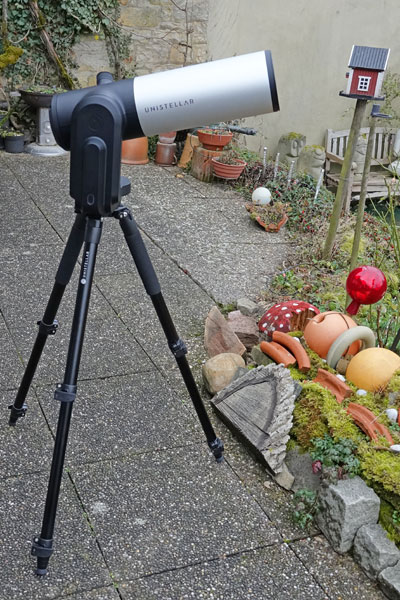 |
 |
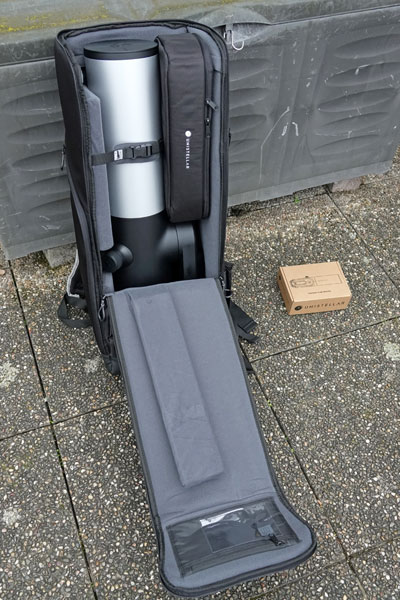 |
>> For details see page Unistellar eVscope - Information.
First of all, the eVscope is a 4.5" Newtonian telescope (primary mirror diameter 112 mm, focal length 450 mm, aperture ratio f/4) on an Alt AZ GoTo mount. What is special about the eVscope, however, is that it should be able to show its owners images of sky objects that are reminiscent of photos taken with large or space telescopes (of course in a lower resolution, but at least in a similar fashion) and even in color. This is made possible by installing a camera chip at the location of the secondary mirror (which is discarded), and an electronic viewfinder built into the eyepiece. The telescope is easy to operate and works more or less fully automatically. After purchasing the eVscope 2 in late 2021, I sold the original eVscope in March 2022.
Atik Infinity Colour Camera (November 2017 to January 2023)
Experienced Kickstarter supporters, however, rather expected one or more years more to delivery than November 2018... Therefore, I decided to also buy a similar solution (which may be more flexible, but may also be much more cumbersome to install and operate) in order to get already an idea of the possibilities of the eVscope. But note that this solution is still much simpler than "true" astro photography. It is an Atik Infinity Color camera (it has a similar Sony chip as the eVscope, but the chip size is larger, and it is a CCD chip) that I put on my Sky-Watcher Star Discovery mount and primarily on my 6" Explorer 150PDS Newton tube (except for the camera, this is a "pure" Sky-Watcher solution...). However, after a busy "initial phase" I did no longer use the camera and mostly observed visually (and manually) instead. After using the camera a little more (2021, 2022), I decided to sell it at the end of 2022.
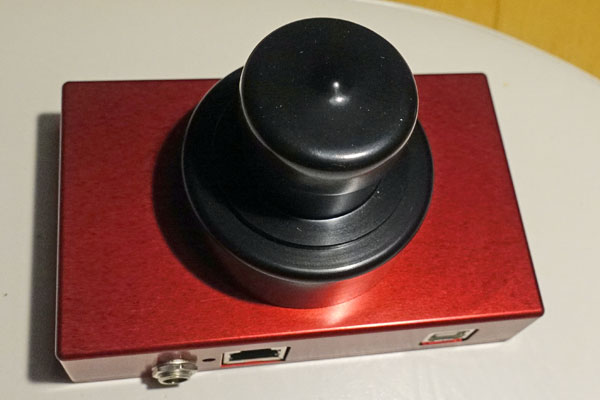 |
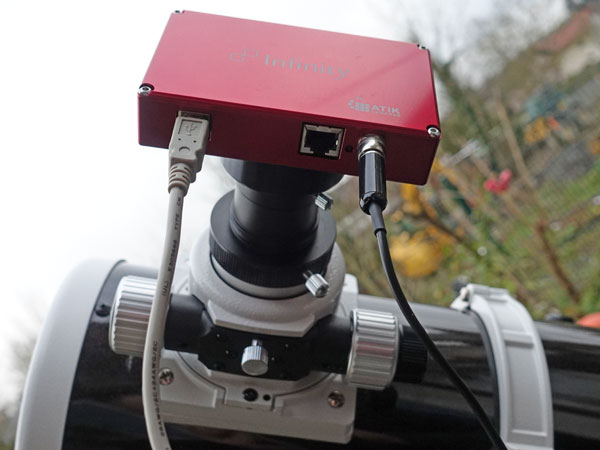 |
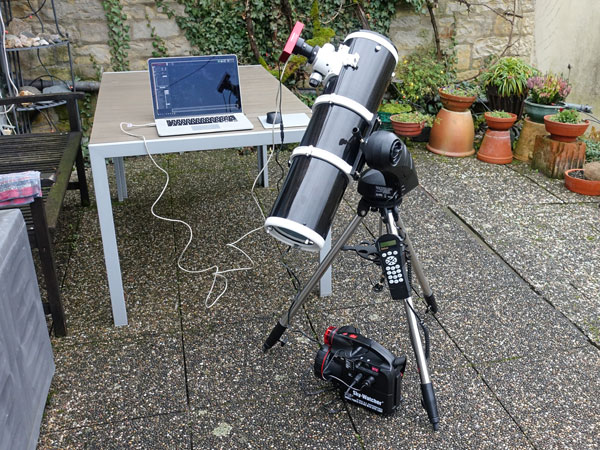 |
>> For details see page Atik Infinity Colour Camera - Information.
Celestron StarSense AutoAlign for Sky-Watcher (February 2018 to November 2022)
After I had had very different experiences with the alignment of the Star Discovery mount and had seen with the eVscope that it can align itself automatically, I thought to further approximate my "preview configuration" to the eVscope and to supplement it with a Celestron StarSense module, which in the meantime was also available in a version for Sky-Watcher mounts. The entry into this world turned out to be absolutely "tricky" and frustrating "thanks" to the misleading manuals, and in the end the module still does not work satisfyingly for me... I was already decided to part with it again - but did not... But I finally did so in mid-November 2022.
>> For details see page Celestron StarSense AutoAlign for Sky-Watcher Information.
More Attention to the Moon (from Spring 2018 on)
The moon was certainly the sky object I had observed the most, but by then I had at best wandered a little along the moon surface and taken photos, mostly total views, of the moon. But what I exactly saw there, I did not know. Other astronomers, on the other hand, repeatedly reported how interesting they found the moon as an observation object. For me, however, it was rather a "troublemaker" that disturbed the observation of DSO. According to my astronomy dealer Mr. Kloß, however, there is actually almost always something to observe, provided that the sky is not completely overcast - and in such a case often only the moon comes into question.
Since "nothing comes from nothing," I decided to follow my DSO example and invest a little more time in the moon, as well. In the meantime, I have created a lot of Web pages about the moon, among them pages with photos of the moon phases, sections from moon photos, landscape forms, and a "moon alphabet." After that, the moon presented itself from its best side and had two total eclipses! Since then, I also find many objects visually that I was not able to find before - only later on photos. I have to admit, however, that despite my really intensive occupation with the moon, I always forget the crater names...
>> For details see page Walking the Moon with My Own Photos - Overview.
Sky-Watcher AZ Pronto Mount (August 2018)
Due to changes in my astronomy equipment, my used Skymax-127 that I had bought at the end of 2017 no longer had suitable base. The far too small Mini Dobson base of the Heritage 100P had problems with the locking of the vertical axis: If I tightened the screw of the Mini Dobson base in a certain vertical position, the vertical axis still moved slowly further - and far too fast for observing or photographing, if higher magnifying eyepieces were used. In addition, during the total eclipse of the moon in July 2018, I noticed that my photo tripods had exactly the same issues. With one of my tripods, the vertical axis slipped even through and could not be locked any more, whenever the telescope tube pointed too high up.
I finally wanted to bring this misery to an end and asked my astronomy dealer Mr. Kloß for advice on simple azimuthal mounts. He recommended the Sky-Watcher AZ4 and the AZ Pronto mounts. I decided for the latter, because the Skymax-127 can be mounted with the viewfinder in a top position, even though the AZ Pronto, having a load capacity of up to 3 kg, is already overloaded with the Skymax-127. Like the AZ3 mount, it has flexible shafts for easy fine tuning of the two axes. The future will show whether the AZ Pronto is really overloaded with the Skymax-127, or whether this combination is "workable" - so far it looks like the latter to me.
 |
>> For details see page Sky-Watcher AZ Pronto Mount Information.
First of all, this mount has become my "workhorse" for my smaller telescopes. I particularly like the operation with the two flexible shafts; I can even observe objects close to zenith (not necessarily comfortably...). If something disturbs me about this mount, it is the trembling that can sometimes make focusing time-consuming at high magnifications. This applies all the more to moon photos taken with the projection method. Here focusing gets really difficult, because there are also delays of the camera's electronic viewfinder in low light.
Omegon Photography Scope 72/432 OTA (September 2018)
In September 2018, my wife and I visited the astronomy fair AME2018 in Villingen-Schwenningen (our first fair of this kind), and especially my wife noticed a "cute" Omegon refractor, which stood out in handling from other refractors - with its two focus rings it was more like a camera to operate. Having the long name Omegon Apochromatic Refractor Pro APO AP Photography Scope 72/432 ED OTA, this refractor tube is especially well suited for DSO rich-field observations, but also for the sun and the moon (it does not enlarge enough for planetary observations). It can also be used as a spotting scope (with Amici prism) and as a camera lens. After a long struggle, actually I did not want to buy a new telescope, we decided to order a sample - not without catching a cold from the seller, which prevented us from taking part in the wedding of one of my nieces afterwards. The refractor was delivered soon, so I could take it on holiday to France and test it there under a dark sky, where it proved itself quite well.
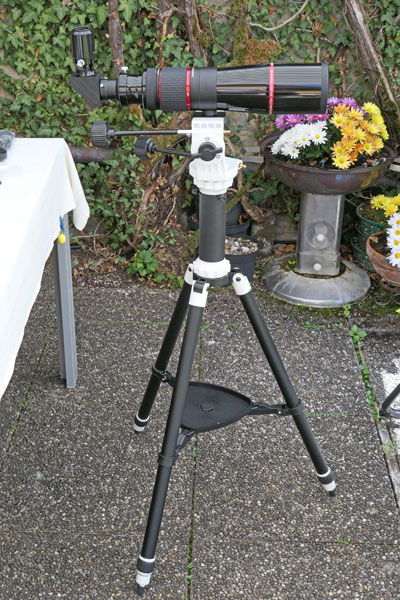 |
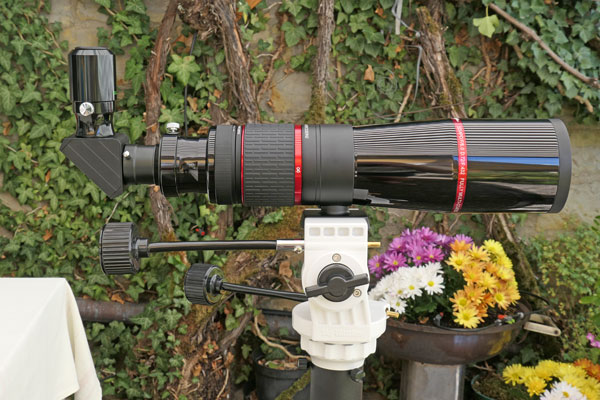 |
>> For details see page Omegon Photography Scope 72/432 ED OTA Information (2.8" Refractor).
On vacation, however, I did not like the focusing so much anymore, and I complained about it. I sent the telescope in for inspection, but got it back unchanged as being "within the norm."
Using the refractor, I was able to observe a lot of DSO, especially in autumn 2018, but also in winter 2018/19. Mostly I use the tube on the AZ Pronto mount (a photo tripod works also). I also use this tube on the Sky-Watcher AZ-GTi AZ GoTo mount when I want to take photos.
Photos
Sony RX10 M3 and M4 (Decenber 2018, March 2019)
In December 2018, I directed my Sony RX10 M3 at the moon for the first time. With an equivalent focal length of 600 mm, the moon diameter is about 900 pixels in size. The camera does not resolve as well as my telescopes, but for many situations this is sufficient or can serve as a "backup," whenever there are issues with a telescope. I used it as a backup, for example, during the partial lunar eclipse in July 2019. In March 2019, I exchanged the RX10 M3 for a new M4 and continued the lunar photography with it. If you take a closer look at the photos, however, you can also see that the 1" sensor smears the details quite a bit compared to larger sensors...
Photos
- Moon December 20, 2018 (M3)
- Moon mid-February 2019 (M3) - Moon (Full) February 19, 2019 (M3)
- Test Photos of the Moon with RX10 M4 - July 2019 - Ditto with RX10 M4 Part 2 - July 2019 - Ditto with RX10 M4 Part 3 - July 2019 (M4)
- Partial Eclipse of the Moon 2019 (M4)
SynScan WLAN (May 2019 - November 2024)
Initiated by an inquiry of a star friend I found out that Sky-Watcher now only delivers their Star Discovery AZ GoTo mount with a WLAN module and without a handbox. This module can be retrofitted, and after initial dissuasion because of my Apple computer environment, my astronomy dealer Mr. Kloß gave me a module for "evaluation" in May 2019 (as a compensation he later got my cable-based SkyWire adapter). In fact, working with this module was a story of failure at the beginning. Gradually, however, I got the module to work (you cannot do certain things...) and I am also quite happy with the simplicity of the alignment and the accuracy of the module (which might make the Celestron StarAlign superfluous...).
>> For details see page Sky-Watcher Star Discovery AZ GoTo Mount - SynScan WLAN Information.
Now I have the choice between handbox, SynScan WLAN (with and without SkySafari) and StarSense (with and without SkySafari). Which solution will receive the preference, was never clarified for me...
In November 2024, I sold the Sky-Watcher SynScan WLAN adapter together with the Star Discovery mount.
Sky-Watcher StarTravel 120/600 OTA (September - October 2019)
Because of the often read praise, refractors, with which I had no experience at first, have enticed me to buy one again and again in recent years. Every time I found a somewhat cheaper refractor on the Internet, I called my astronomy dealer Mr. Kloß and asked for his opinion about the respective device. And he advised against it again and again because of the strong color errors, so that at first the purchase of a refractor simply did not happen. This changed in September 2018, when I came across the Omegon refractor PS 72/432 ED at the AME2018 astronomy fair in Villingen-Schwenningen and ordered one (see above). All in all, I am satisfied with it, but something bothered me: I was not able to find quite a few DSO even at the dark night sky in France. And so a suspicion germinated in me: An aperture of 72 mm might perhaps be a little small.
In my search for refractors with more aperture, I quickly was confronted with limits, especially financial ones. The only refractor with a large aperture that is inexpensive is the Sky-Watcher refractor AC 120/600 StarTravel OTA (or its Orion counterpart). But this is a refractor of the Fraunhofer type and is therefore often called a "paint bucket." In other words, despite an otherwise good optical quality, color fringes can be expected. So the question arose: How much do these color fringes disturb in practice and under what conditions are they still acceptable? You can only answer this question for yourself by testing the device. I decided to do this by buying the refractor, but not without asking my astronomy dealer again about this specific refractor (August 2019). In a telephone call he called the refractor inexpensive and, in view of its low price, also "worth considering." However, it is, according to him, too similar regarding the technical data to my Sky-Watcher Explorer 150PDS and would therefore compete with it. Thus, the wind was taken out of my sails, although I would have liked to take the refractor on vacation to France and test it there...
>> For details see page Sky-Watcher StarTravel 120/600 OTA Information (4.7" Refractor, Borrowed).
But not quite, because I know a hobby astronomer with whom I exchange e-mails and who owns such a refractor. I asked him about his opinion about the refractor, as well, and he offered to lend me the refractor for a while. He even allowed me to take it with me on vacation. I could not refuse this generous offer, the handover was exciting (beginning of September 2019), and I tested the refractor on vacation (I visited about 50 DSO there, including 20 new ones for me) - and also at home under various conditions.
After the test (I returned the ST120 in October 2019), I was about as smart as before: as everyone told me, I do not really need it, but at DSO it showed a good performance for me that was better than that of my PS72. In any case, this "borrowing experiment" was an interesting experience, but I will probably do nothing further in this direction...
A Step Back in the Direction of a "Larger Aperture" - Celestron C8 (November 2019 - November 2022)
After some "back and forth" in my telescope history, I was down to three telescopes in spring 2019, which complemented each other quite well: the refractor PS 72/432 was used for rich-field and DSO observations, especially on vacation, the Skymax-127, as a Mak with longer focal length, was good for observing the sun, the moon, and the planets - and maybe also for DSO observations, at least on vacation, and the Explorer 150 PDS tube was my "universal telescope," which is also suitable for "fast" astro photography with the Atik Infinity camera. I used the two small telescopes "manually" on the AZ-Proto mount, this is also possible during "stationary" holidays, and the large one (and the two small ones, of course, as well) only on the motor-driven Star Discovery mount.
Nevertheless, there was still no "peace" for me in this state, and when I found an advertisement for a 6" Cassegrain tube during my vacation, this seemed to me to be the ideal solution to further simplify my telescope collection and to replace both the Skymax-127 AND the Explorer 150PDS with this tube. This idea also opened my eyes to Schmidt-Cassegrain telescopes, which I had not considered before. It turned out that the Celestron C8 is thicker than the new 6" Cassegrain, but not heavier, and even slightly shorter! Maybe that would be another 8" aperture for me that I might still be able to handle!
A star friend who owns a C8 gave me the opportunity to "weigh" the C8 and try it out on my Star Discovery mount. A comparison between the C8 and my 6" Newton tube was, however, unfortunately prevented by upcoming clouds. So far everything seemed to fit. When I found a very reasonable price for the C8 at my astronomy dealer Mr. Kloß, I almost ordered it. But then I waited a little bit and consulted my star friend before I contacted Mr. Kloß. The 6" Cassegrain was quickly eliminated because, according to Mr. Kloß and some Internet sources, it is difficult to collimate and has to be collimated often, the C8 is much more "good natured" in this respect. And since Mr. Kloß was not able to talk me out of the C8 or buying a new one ("You buy a C8 used!"), I finally ordered it from him - after another reflection period, during which I was also looking for used C8s.
>> For details see page Celestron C8 OTA Information (8" Schmidt-Cassegrain).
On November 14, 2019, the C8 arrived at my home, and my first experiences with it are quite positive. I can see many sky objects easier and better than with small telescopes!
At the beginning of November 2022, I sold my C8, because I had used it too rarely.
Sky-Watcher AZ4 Mount (December 2019 - May 2021)
>> For details see page Sky-Watcher AZ4 Mount Information.
In mid-December 2019, I also purchased a Sky-Watcher AZ4 mount for observing manually with the C8. Since I did not like this mount so much, I ordered a GSO mount in January 2021 (not yet arrived) and sold the AZ4 mount at the end of May 2021.
Finally a Better Refractor - TS-Optics TLAPO1027 (July 2020 - October 2024)
Even after a the exchange of my 6" Newton for a C8, I still longed for a refractor with pure colors, and I was also willing to spend a little more money for it (about 2000 EUR). When I wanted to reward myself for some "personal reason", the time had come for me to buy a refractor in July 2020. I chose some models and asked my astronomy dealer for his opinion on them. This time I, was "absolutely right" with a refractor from TS-Optics! I had however a more expensive, similar model in mind and wanted to buy this with a lighter focuser. First of all, according to my dealer, both tubes were identical, even if some Websites state slight differences, and secondly, a conversion to a lighter focuser did not seem possible, although TS-Optics advertises with it on its Website. There were also inconsistencies in the tube weights...
In the end, I decided for the device suggested by my dealer, the TLAPO1027 from TS-Optics. But all of a sudden, this device was no longer available from my dealer, and he did not receive a delivery of already promised devices either. After some back and forth, we postponed to "later" (in several months, how many, was unknown...). When I then went back to my dealer for another similar refractor, he advised me not to buy it, but he wrote that I should buy the TLAPO1027 if I would find it at another dealer, because "it is worth it". In fact, I bought it from another dealer who stated on his Website that he was able to deliver it within 1-4 days. But the dealer was probably not aware of the seriousness of the delivery situation. Astonishingly, after some back and forth he was able to deliver it (drop shipment from TS-Optics), because in some corner at TS-Optics a last sample could be found. That actually arrived at my home! However, someone must have taken the "drop shipment" too literally, because the "very stable aluminium case" was unfortunately damaged. In the end, I decided to store and carry around the tube in a soft bag. In December 2020, I gave the case away to a star friend.
>> For details see page TS Optics Photoline 102/715 Information (4" Refractor)
In a first comparison during day and night (M 3) the refractor showed itself clearly superior to my Omegon refractor PS 72/432.
I sold my TS-Optics Photoline 102 mm f/7 in the beginning of October 2024, because I had used it to rarely.
And Another Electronic Telescope - Vaonis Vespera (Ordered October 2020, Received July 2022, sold June 2024)
Vespera is the second telescope that the French company Vaonis wants to develop. For this purpose, Vaonis started a Kickstarter campaign on October 1, 2020, which I backed very early to get an early-bird offer - and I succeeded. I learned about this campaign because Vaonis contacted me personally. The campaign will end at October 31, 2020. Provided the funding goal will be reached, the development of the telescope can go on, until finally the mass production begins. Delivery of the telescope was scheduled for Christmas 2021, but was delayed until May 2022 or even later. In the end, I received my Vespera at the end of July 2022 and the second part of the Adventurer Pack in mid-September 2022.
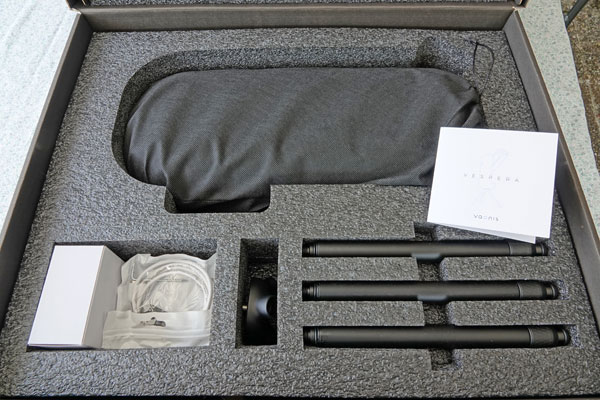 |
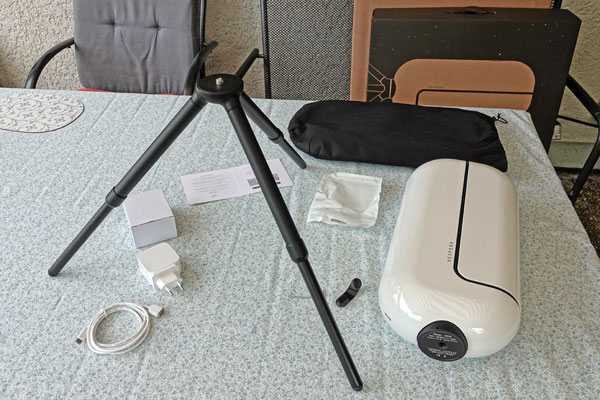 |
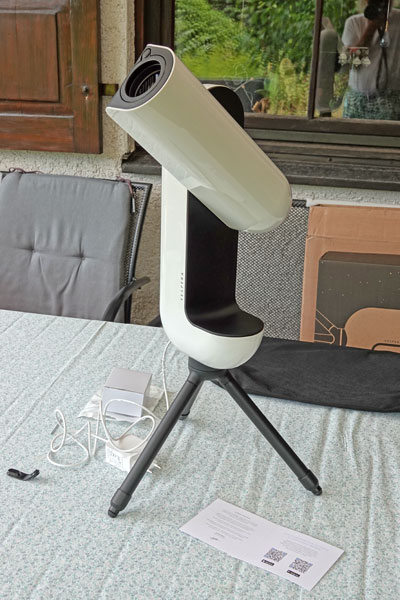 |
>> For details see page Vaonis Vespera - Information
After receiving the Vespera Pro in May 2024, I decided to sell the original Vespera in June 2024.
And just Before Christmas 2020, a New Travel and "Fast Observing" Telescope (December 2020).
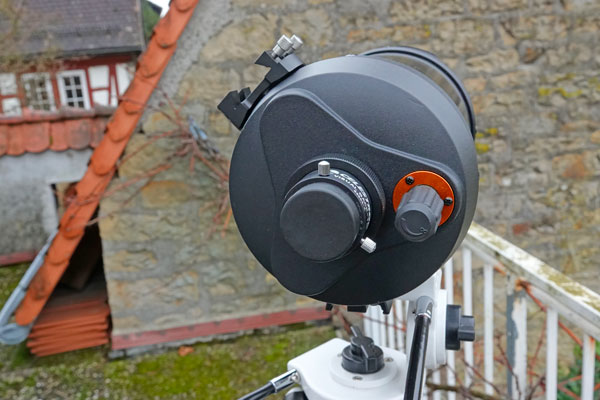 |
||
C5 - side view on the AZ Pronto mount with the original finder and as a spotting scope |
C5 tube, oblique front view |
C5 tube from the rear |
This was probably my fastest telescope purchase so far! A star friend wanted to look at my Celestron C8 at my home (December 2020), which unfortunately turned into a somewhat chaotic event. Apparently, the C8, which he had considered as a Christmas present for himself, was too bulky for him. So he decided to buy a C6 with a GoTo mount. He told me this and asked whether he should aim for a 1.25" or for a 2" solution for rich field observations. And so I turned to the C6 (or returned, because I had considered it briefly when I finally bought the C8) to find out whether it can handle 2" accessories. I could remember that one of the reasons that I did not buy the C6 was precisely because it cannot handle 2" accessories. Instead, I bought the C8. I then also found sources on the Internet confirming this and communicated this to the star friend. He, however, nevertheless decided on a 2" solution.... I then again took a closer look at the C6 for curiosity; but with a weight of 5 kg (not much less than the C8) and a price around 850 EUR it was not for me...
So I looked for its little "brother", the Celestron C5. This tube is marketed by Celestron as a spotting scope, but I call it "OTA" here and not "spotting scope", because it can also be used well astronomically (there is also a NexStar version of it). The C5 is resembles my Skymax-127 in many respects, but weighs less so that it can still be operated on the Sky-Watcher AZ Pronto mount without problems. And with the f/6.3 reducer/corrector that I already own, one can also go a bit further into the realm of rich field observations than is possible with the Skymax-127. In other words, the C5 seemed more handy and more universal than the Skymax and would therefore be an ideal telescope for travel and quick observing. However, the price of about 650 EUR quickly put an end to such thoughts. The Skymax-127 is available new for about half the price new - and I already own it. But then I came across an offer of just under 430 EUR! After a short inner struggle, I ordered the C5!
For details see page Celestron C5 OTA Information (5" Schmidt-Cassegrain).
Sky-Watcher AZ-GTi - A New GoTo Mount for My Small Telescopes (End of January 2021 - October 2024)
At the end of January 202, I purchased a Sky-Watcher AZ-GTi mount head,which can be used on the tripod of my AZ Pronto mount, in order to have a GoTo mount for my C5 and PS 72/432 tubes. This combination also allows for a portable GoTo setup.
At the beginning of February, I furthermore bought a Wedge for the Sky-Watcher AZ-GTi and some smaller parts, in order to be able to use the mount in EQ mode as well.
>> For details see pages Sky-Watcher AZ-GTi-Mount Information and Wedge for Sky-Watcher AZ-GTi AZ GoTo Mount
I sold my Sky-Watcher AZ-GTi mount including the Wedge for the Sky-Watcher AZ-GTi at teh beginning of October 2024.
ZWO ASI224MC Camera (April 2021 - April 2022)
At the end of April 2021, I bought a used ZWO ASI224MC camera from a starfriend. This camera uses the same Sony sensor as my eVscope (Sony IMX224/225), so I was interested in finding out how it would perform on my telescopes in comparison with the eVscope and my Atik Infinity camera.
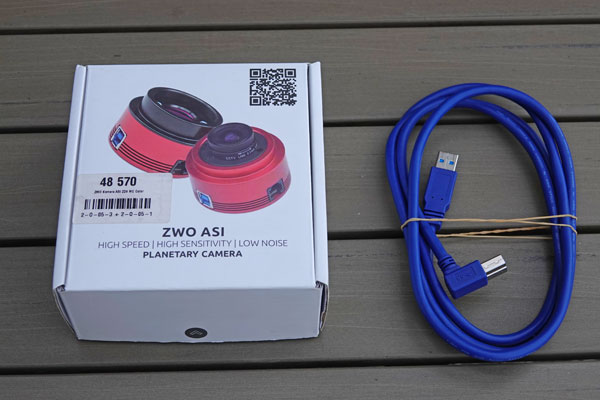 |
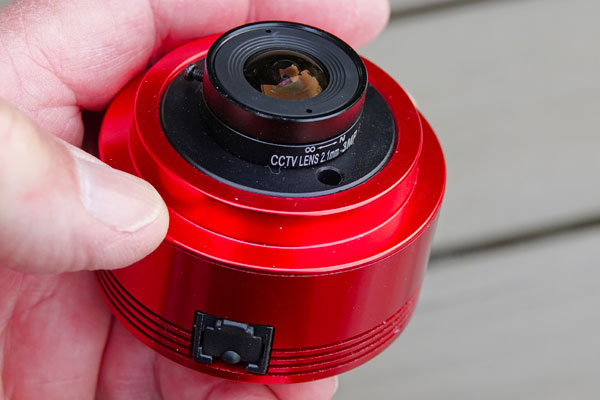 |
>> For details see page ZWO ASI224 Color Camera - Information
However, with the ASI224MC, I had trouble safely accessing and tracking targets (with the AZ-GTi mount and the StellarMate astronomy computer), which I attributed to the camera's narrow field of view. So I purchased a ZWO ASI294MC in early April 2022 and sold the ASI224MC in mid-April 2022.
Sky-Watcher Stainless Steel Tripod (AZ5) (May 2012 - November 2024)
In May, I purchased a Sky-Watcher Stainless Steel Tripod (AZ5) for the Sky-Watcher AZ-GTi mount, because I found the AZ Pronto tripod somewhat "shakey"...
|
Mount assembled |
Mount with AZ-GTi mount head |
Ditto |
>> For details see page Sky-Watcher Stainless Steel Tripod (AZ5) - Information
I sold the tripod in November 2024, because I had used it only rarely.
Unistellar eVscope 2 (Ordered October 2021, Delivered Beginning of December 2021, Final Sample in August 2022; Sold in December 2023)
In October 2021, I ordered the successor of the eVscope, the eVscope 2. It was delivered on December 3, 2021. This model looks similar to the original eVscope, but offers a new sensor chip (IMX347) and an improved electronic eyepiece (designed by Nikon). In many respects, the eVscope 2 looks like "what the original eVscope should have been"... My eVscope 2 came with a primary mirror that was under tension; it was repaired free of charge by Unistellar. However, the repair was not a complete success. This was exchanged for a second sample that also had problem with image quality. In the end, I got a third and final sample in August 2022, which I sold in December 2023 (too much competition with the Vaonis Vespera).
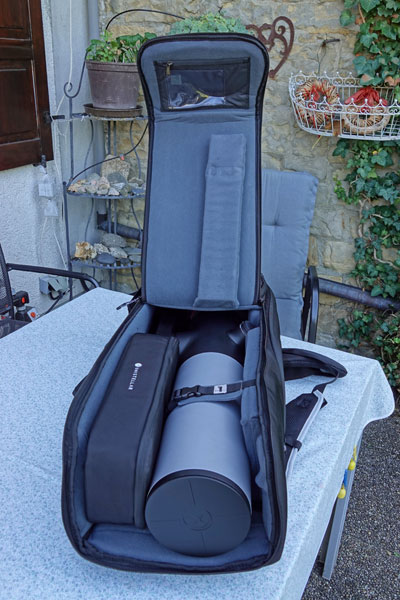 |
>> For details see page Unistellar eVscope 2 - Information.
In December 2023, I sold my eVscope 2 because it was competing with the Vespera.
Ikarus StellarMate Plus (End of October 2021 - June 2024)
At the end of October 2021, I bought an Ikarus StellarMate Plus astrophotography computer. I gave it away in June 2024.
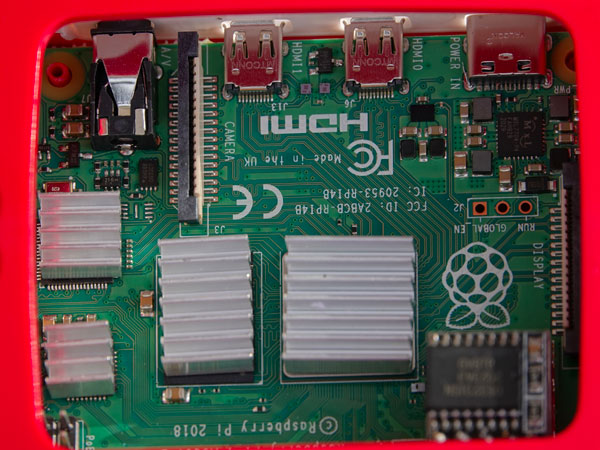 |
>> For details see page Ikarus StellarMate Plus - Information
I gave away my Ikarus StellarMate Plus in June 2024.
ZWO ASI294MC Camera (Beginning of April 2022 - November 2024)
At the beginning of April 2022 I bought a used ZWO ASI224MC camera in the astronomie.de forum (offers). This camera has a modified 4/3" sensor, a large field of view, and a lot of pixels.
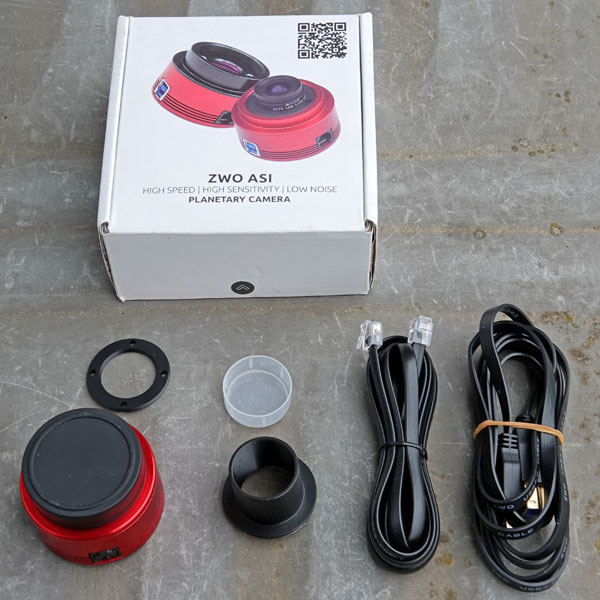 |
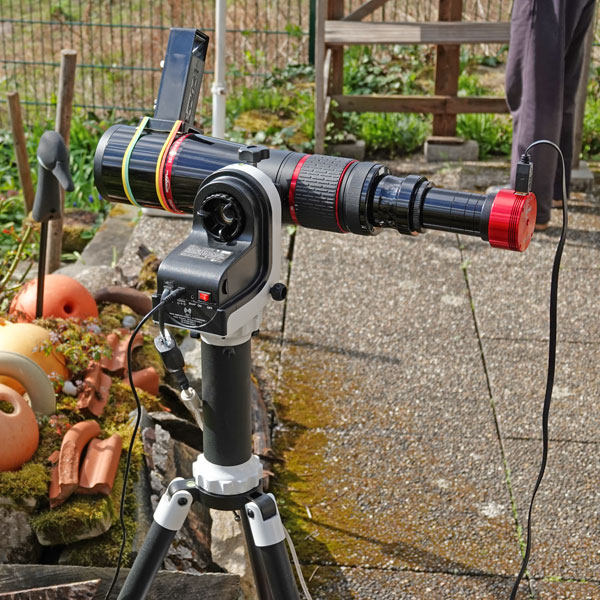 |
>> For details see page ZWO ASI294 Color Camera - Information
I sold the camera at the end of November 2024, because I had used it only rarely.
ZWO ASI462MC Camera (December 2022 - June 2024)
In December 2021, I bought a mint ZWO ASI224MC camera from a starfriend. This camera uses the same Sony sensor as my Vespera (Sony IMX462), so I was interested in finding out how it would perform on my telescopes in comparison with the Vespera.
 |
 |
>> For details see page ZWO ASI462 Color Camera - Information
At the beginning of June 2024, I sold my ZWO ASI462MC color camera, because I had never used it.
Vespera / Stellina Gitzo Systematic High Tripod (June 2023)
After taking part in the Vaonis competition for the best photos of Messier objects in spring 2023, I received a voucher for Vaonis accessories because some of my photos had been published. However, I owned already most of the accessories for the Vespera, either I had purchased them or had received them with the Adventurer Pack. The only thing I was missing was the Vespera / Stellina Gitzo Systematic High Tripod (Gitzo GT3533S-VS; Series 3, normal length, three leg sections; see Gitzo Website), i.e. a larger tripod. Gritting my teeth, I ordered this one in June 2023 because I did not want to let the voucher unused...
Vespera without cover on the tripod |
Vespera on the tripod, arm moved |
Tripod with Vespera, both segments pulled out |
>> For details see page Vaonis Vespera - Adventurer Pack and More Accessories
And One More Electronic Telescope - Vaonis Vespera Pro (Ordered June 2023, Received May 2024)
In June 2023, Vaonis announced a new telescope, the Vespera Pro. It is a successor to the Vespera, offers a better sensor and provides some changes compared with the original Vespera. The most striking difference is probably the new sensor, which offers nearly double the resolution of the original Vespera's sensor. Since I am convinced of the Vespera concept, I immediately preordered the Vespera Pro and got it in the beginning of May 2024 (and sold my Vespera...).
|
>> For details see page Vaonis Vespera Pro - Information
And Once Again a Refractor (November 2024)
The TS-Optics Photoline 80 mm f/6 FPL53 Triplet Apo with 2.5" RPA focuser is regarded as exhibiting very little color fringing with respect to its price. That is why I bought it in November 2024 in order to replace my Omegon refractor PS 72/432 and to have a better compact refractor at my disposal. However, I decided to keep my PS 72/432 and use it in our vacation apartment in Northern Germany.
I operate the refractor on my Sky-Watcher AZ Pronto mount and intend to use it only visually and manually.
>> For details see page TS Optics Photoline 80/480 Information (3.2" Refractor). For technical data see here.
AZ5 Mount Head (December 2024)
In December 2024, I purchased a Sky-Watcher AZ5 mount head. On this mount head, together with my Gitzo carbon tripod, I intend to operate my recently purchased TLAPO804 refractor.
>> For details see page Sky-Watcher AZ5 Mount Head.
Timeline
- 1997: Comet Hale-Bopp observed from an airplane going from Atlanta, GA to Frankfurt/Germany at night
- 1998 or earlier: Bought a Bresser Venus 76/700 AZ Newtonian telescope (when and where is unknown to me...)
- 1999:
- Photos of the moon taken with the Bresser Venus 76/700 AZ telescope
- Bought a Meade ETX-90EC Maksutov-Cassegrain GoTo telescope (May); sold the Bresser Venus to my brother in law
- Observed the total eclipse of the sun with the ETX-90EC (August)
- 2000: Took photos of sun spots with the ETX-90EC (June/July)
- 2004: Observed the Venus transit through the sun with the ETX-90EC (June)
- 2004-2009: Failed when trying to observe a comet 153P/Ikeya-Zhang (probably, 2002), the Andromeda galaxy M 31 was hardly visible...
- 2009:
- Purchased a Meade 10" Lightbridge Dobsonian telescope (October)
- Sold the Meade ETX-90EC via a dealer (at the end of the year)
- 2010: Bought a Sky-Watcher Heritage P130 Dobsonian telescope for travel (February)
- 2014: Bought a Sky-Watcher Heritage 76 Dobsonian telescope for travel (end of January), because the P130 was still a bit too large and heavy for travel
- 2015:
- Took photos of a partial eclipse of the sun (March)
- Bought a Sky-Watcher Heritage 100P Dobsonian telescope for travel (beginning of July), because the image quality of the Sky-Watcher Heritage 76 was disappointing; the 100P was much better.
- 2016:
- Sold the Meade 10" Dobson Lightbridge to a former colleague (March), gave the Sky-Watcher Heritage 76 away together with the Lightbridge
- Purchased a GSO GSD 680 8" Dobsonian telescope (end of March)
- Took photos of/observed the Mercury transit of the sun with the Sky-Watcher Heritage 100P (beginning of May)
- Bought a Sky-Watcher Heritage 114P/Virtuoso (tracking only) and returned it after a month because of technical issues (May/June)
- Bought a Sky-Watcher Skymax-102 OTA (Maksutov-Cassegrain) for observing the moon, sun, and planets (May)
- Bought a Sky-Watcher Star Discovery AZ GoTo Mount as a replacement for the Virtuoso mount (July); now I had entered the world of GoTo!
- Purchased a SouthernStars SkyWire Serial Accessory (July) in order to control the Star Discovery mount with SkySafari
- Start of "real" DSO observations, manually as well as using a GoTo control (summer); for this purpose, I created lists of recommended DSO and observation lists; this is still an ongoing activity of mine...
- 2017:
- Took photos of a deep penumbral lunar eclipse (February)
- Bought an Omegon 76/300 telescope for kids (end of February 2017; identical to the Sky-Watcher Infinity 76 telescope)
- Borrowed a Celestron 76 Dobsonian telescope and tested it (end of February to mid-March)
- Purchased a Sky-Watcher Explorer 150PDS 6" Newtonian telescope tube (beginning of April)
- Gave away my Sky-Watcher Heritage P130 to a friend (April)
- Gave my GSO GSD 680 telescope to a dealer in commission who sold it for me (April)
- Bought TS 10 x 60 LE Porro binoculars (October)
- Bought a used Sky-Watcher Skymax-127 OTA (November)
- Participated in a Kickstarter campaign for the Unistellar eVscope (mid-November)
- Purchased an Atik Infinity Colour Camera (end of November) as a "preview" of the eVscope; first photo attempts with this camera and various telescopes
- 2018:
- Further photo attempts with the Atik Infinity Colour Camera and various telescopes (until end of February)
- Bought a Celestron StarSense for Sky-Watcher module (February) for automatic alignment
- Started more intensive activities regarding the moon, created many new pages on this topic (since February)
- Took photos of and observed a total eclipse of the moon (end of July)
- Purchased a Sky-Watcher AZ Pronto Mount (August)
- Bought Omegon wide-field binoculars 2.1 x 42 for observing star fields (August)
- Sold my Sky-Watcher Skymax-102 OTA (end of August)
- Ordered an Photography Scope 72/432 ED OTA on the AME2018 fair and received it soon after; took it with me on vacation to France (September/October); returned the scope because of focusing issues, but got it back unchanged because it was "within the tolerances"...
- 2019:
- Gave away my Omegon 76/300 kids telescope (end of January)
- Took photos of and observed another total eclipse of the moon (end of January)
- My astro dealer Mr. Kloß gave me a SynScan WLAN module for evaluation (March); I gave him in return my SouthernStars SkyWire Serial Accessory (May)
- Gave away my Sky-Watcher Heritage 100P to my brother (March) >> now I owned just three telescopes (PS72, SM127, EXP150PDS)
- Took photos of and observed a partial eclipse of the moon (mid-July)
- Borrowed a Sky-Watcher StarTravel 120/600 OTA refractor and took it with me on vacation to France (September/October)
- Purchased a Celestron C8 in mid-November.
- Bought a Sky-Watcher AZ4 mount for observing manually with the C8 in mid-December.
- 2020:
- Sold my Sky-Watcher Explorer 150PDS in mid-January >> now I owned just three telescopes (PS72, SM127, C8)
- Finally received my Unistellar eVscope (January 27, 2020) >> now it were four of them again...
- Got my TS Optics Photoline 102/715 refractor (July 8, 2020) >> now it were even five of them...
- Supported the Vaonis Vespera refractor on Kickstarter (October 1, 2020) >> delivery was scheduled for Christmas 2021 but delayed to May 2022.
- Purchased a Celestron C5 in December (received on December 19, 2020) >> now it were even six of them... (meant to replace the Skymax-127)
- 2021:
No longer count my telescopes...
- Ordered as GSO GSAZ mount in mid-January; never delivered (refunded in 2024)
- Sold my Sky-Watcher Skymax-127 OTA at the end of January.
- Purchased a Sky-Watcher AZ-GTi mount at the end of January (for the PS 72/432 and the C5). Bought a Wedge for the Sky-Watcher AZ-GTi at the beginning of February, in order to be able to use the mount in EQ mode as well.
- Bought a used ZWO ASI224 Color Camera at the end of April.
- Purchased a Sky-Watcher Stainless Steel Tripod (AZ5) for the Sky-Watcher AZ-GTi mount in May.
- Sold my Sky-Watcher AZ4 mount (May 2021).
- Ordered a Unistellar eVscope 2 on Oktober 10, 2021 >> delivered on December 3, 2021
- Bought my Sky-Watcher Skymax-127 OTA back (October 20, 2021); also bought an adapter for 2" and SC accessories.
- Bought an Ikarus StellarMate Plus astronomy computer (end of October 2021).
- 2022:
- Sold my Unistellar eVscope (March 15, 2022).
- Bought a mint ZWO ASI294 Color Camera (beginning of April 2022).
- Sold my ZWO ASI224 Color Camera (mid-April 2022).
- Got my Vaonis Vespera (mid July 2022)
- Got my third and final sample of the eVscope 2 (end of August 2022)
- Received the second part of the Vaonis Vespera Adventure Pack (mid-September 2022)
- Sold my Celestron C8 (beginning of November 2022) )
- Sold my Celestron StarSense module (mid-November 2022)
- Sold my Explore Scientific Focal Extenders 3x, 5x, and 2x (November/December 2022)
- Bought a mint ZWO ASI462 Color Camera at the end of December 2022.
- Sold my Atik Infinity camera (December 2022/January 2023).
- 2023:
- Preordered a Vaonis Vespera Pro (June 2023).
- Bought a Gitzo High Tripod (July 2023; see my page)
- Sold my Unistellar eVscope 2 (end of December 2023; handed over to the new owner in the beginning of January 2024).
- 2024:
- Got my Vaonis Vespera Pro (beginning of May 2024).
- Sold my Omegon wide-field binoculars 2.1 x 42 for observing star fields (end of May 2024).
- Sold my ZWO ASI462 Color Camera (June 2024).
- Gave away my Ikarus StellarMate Plus (June 2024).
- Sold my Vaonis Vespera (June 2024).
- Money back for GSO GSAZ (end of June 2024)
- Sold my TS Optics Photoline 102/715 refractor (beginning of October 2024) >> now I owned just three telescopes (PS72, SM127, C5; plus one smart telescope, the Vaonis Vespera Pro)
- Sold my Sky-Watcher AZ-GTi mount including the Wedge for the Sky-Watcher AZ-GTi (beginning of October 2024).
- In November, I sold my Sky-Watcher Skymax-127 OTA >> now I owned just two telescopes (PS72 and C5; plus one smart telescope, the Vaonis Vespera Pro)
- At the end of November, I purchased a TS Optics Photoline 80/480 refractor >> now I owned three telescopes (TLAPO804, PS72 and C5; plus one smart telescope, the Vaonis Vespera Pro)
- At the end of November, I sold my Sky-Watcher Star Discovery AZ GoTo mount and my ZWO ASI294 camera.
- In mid-December 2024, I bought a Sky-Watcher AZ5 Mount Head.
Links
- Bresser Venus 76/700 AZ Information (3"-Newton)
- Meade ETX-90EC Information (3.5" Maksutov-Cassegrain)
- Meade ETX-90EC Equipment
- Meade Lightbridge Information (10" Dobson)
- Sky-Watcher Heritage P130 Information (5" Dobson)
- Sky-Watcher Heritage 76 Information (3" Dobson)
- Omegon 76/300 (Sky-Watcher Infinity 76) Information (3" Dobson)
- Sky-Watcher Heritage 100P Information (4" Dobson)
- GSO GSD 680 Information (8" Dobson)
- Sky-Watcher Heritage 114P/Virtuoso Information (4.5" Dobson)
- Sky-Watcher Skymax-102 OTA Information (4" Maksutov-Cassegrain)
- Sky-Watcher Explorer 150PDS Information (6" Newton)
- Sky-Watcher Skymax-127 OTA Information (5" Maksutov-Cassegrain)
- Omegon Photography Scope 72/432 ED OTA Information (2.8" Refractor)
- Sky-Watcher StarTravel 120/600 OTA Information (4.7" Refractor, Borrowed)
- Celestron C8 OTA Information (8" Schmidt-Cassegrain)
- TS Optics Photoline 102/715 Information (4" Refractor)
- Celestron C5 OTA Information (5" Schmidt-Cassegrain)
- Sky-Watcher Star Discovery AZ GoTo Mount Information
- Sky-Watcher Star Discovery AZ GoTo Mount - SkyWire Information
- Sky-Watcher Star Discovery AZ GoTo Mount - SynScan WLAN Information
- Celestron StarSense AutoAlign for Sky-Watcher Information
- Sky-Watcher AZ-GTi AZ GoTo Mount Information
- Wedge for Sky-Watcher AZ-GTi AZ GoTo Mount
- Sky-Watcher AZ Pronto Mount Information
- Sky-Watcher AZ4 Mount Information
- Sky-Watcher Stainless Steel Tripod (AZ5)
- My Binoculars
- My Starfield Binoculars
- Unistellar eVscope - Information
- Vaonis Vespera - Information
- Unistellar eVscope 2 - Information
- Atik Infinity Colour Camera - Information
- ZWO ASI224 Color Camera - Information
- Ikarus StellarMate Plus - Information
- ZWO ASI294 Color Camera - Information
- ZWO ASI462 Color Camera - Information
- Vaonis Vespera Pro - Information
- TS Optics Photoline 80/480 - Information (3.2" Refractor)
- Sky-Watcher AZ5 Mount Head
| 14.03.2025 |




